 Now here's a movie that I had absolutely no clue existed until I found out about it by complete accident. One of the items that I picked up during the time leading up to and after the release of the 1998 TriStar Godzilla movie was an official magazine based around the making of the film as well as to simply hype the film up even more than it already was and near the end of that magazine was an advertisement for a couple of CDs containing the soundtracks of all of the entries in both the Showa and Heisei series of films. The advertisement had a list of the films whose music was featured on these CDs and I think that when I saw the titles listed beneath the Heisei CD (Godzilla vs. King Ghidorah, Godzilla vs. SpaceGodzilla, etc.), I first became really aware that there were more recent Godzilla movies that I didn't know about since they hadn't yet been released in the United States. Just to remind you, I knew of Godzilla vs. King Ghidorah at this point thanks to its recent video release but hadn't seen it yet and therefore, since I also didn't yet have the Godzilla Compendium, didn't understand what it was exactly. In any case, the last title listed beneath the Heisei set was Godzilla vs. The Destroyer. That caught my attention because, since Destoroyah himself was never made into an action figure by Trendmasters (this film hadn't been made yet when that line of toys was released), I had never heard of a monster called the Destroyer and was intrigued because it sounded pretty damn interesting. When I got the compendium, I learned that the film was, at that time, the most recent Japanese-made Godzilla movie and that it was actually meant to be the end since, and this was a shock to me, the film concludes with Godzilla's death. I know that when this film was released in Japan in December of 1995, it actually made headlines in other countries, including over here, since the death of Godzilla was quite a big deal but because I was only eight at the time, I never heard about it and neither did anyone else that I knew (although, I didn't have many friends that were as into Godzilla as I was). Reading up on it and learning that he suffers a devastating meltdown at the end of the film was totally unexpected. While I was old enough by that point to know that the TriStar movie was simply a retelling of Godzilla's story rather than a part of the actual franchise and that, going by that logic, they could revamp everything again to remove the ending of this movie (which they did), the very idea that Godzilla, my hero, a powerful creature that had weathered so much and had come out unscathed, was "dead" wasn't something I was all that willing to accept. But, after I got over that shock, I actually grew kind of skeptical as to how impactful his death could be. Obviously, I saw pictures in the compendium of him flaming up from the film and they described how sad the whole thing was and whatnot but, since I had not yet seen anything involving him that was as moving as when he was dumped into the volcano at the end of Godzilla 1985, I wasn't completely convinced that even his actual death could top that.
Now here's a movie that I had absolutely no clue existed until I found out about it by complete accident. One of the items that I picked up during the time leading up to and after the release of the 1998 TriStar Godzilla movie was an official magazine based around the making of the film as well as to simply hype the film up even more than it already was and near the end of that magazine was an advertisement for a couple of CDs containing the soundtracks of all of the entries in both the Showa and Heisei series of films. The advertisement had a list of the films whose music was featured on these CDs and I think that when I saw the titles listed beneath the Heisei CD (Godzilla vs. King Ghidorah, Godzilla vs. SpaceGodzilla, etc.), I first became really aware that there were more recent Godzilla movies that I didn't know about since they hadn't yet been released in the United States. Just to remind you, I knew of Godzilla vs. King Ghidorah at this point thanks to its recent video release but hadn't seen it yet and therefore, since I also didn't yet have the Godzilla Compendium, didn't understand what it was exactly. In any case, the last title listed beneath the Heisei set was Godzilla vs. The Destroyer. That caught my attention because, since Destoroyah himself was never made into an action figure by Trendmasters (this film hadn't been made yet when that line of toys was released), I had never heard of a monster called the Destroyer and was intrigued because it sounded pretty damn interesting. When I got the compendium, I learned that the film was, at that time, the most recent Japanese-made Godzilla movie and that it was actually meant to be the end since, and this was a shock to me, the film concludes with Godzilla's death. I know that when this film was released in Japan in December of 1995, it actually made headlines in other countries, including over here, since the death of Godzilla was quite a big deal but because I was only eight at the time, I never heard about it and neither did anyone else that I knew (although, I didn't have many friends that were as into Godzilla as I was). Reading up on it and learning that he suffers a devastating meltdown at the end of the film was totally unexpected. While I was old enough by that point to know that the TriStar movie was simply a retelling of Godzilla's story rather than a part of the actual franchise and that, going by that logic, they could revamp everything again to remove the ending of this movie (which they did), the very idea that Godzilla, my hero, a powerful creature that had weathered so much and had come out unscathed, was "dead" wasn't something I was all that willing to accept. But, after I got over that shock, I actually grew kind of skeptical as to how impactful his death could be. Obviously, I saw pictures in the compendium of him flaming up from the film and they described how sad the whole thing was and whatnot but, since I had not yet seen anything involving him that was as moving as when he was dumped into the volcano at the end of Godzilla 1985, I wasn't completely convinced that even his actual death could top that. Boy, was I wrong! As I described in the previous review, I came across the VHSs of both this film and Godzilla vs. SpaceGodzilla one day at an On-Cue in the spring of 1999 and bought them both. I was mainly excited to get SpaceGodzilla but I decided to snag Destoroyah as well, even though, truth be told, I was kind of hesitant to see it. Despite my skepticism, in the back of my mind I was thinking, "God, what if this is really sad and depressing? I don't want to watch something that'll make me start crying!" But, the day after I first watched SpaceGodzilla, I bit the bullet and watched Destoroyah. To say that the film's ending left me devastated is an understatement. I was really numb after the movie was over, mainly because I kept seeing Godzilla literally fall apart and dissolve over and over again in my head. I didn't cry, though; I think I was a little too shocked. But I did have quite a lump in my throat, which stayed there all day long, as did that image and the extremely sad music that played during his death. My step-cousin was just as devastated when I showed him the movie (actually, he talked me into it) and I thought he was the one who was going to start crying. You probably won't be surprised to learn that Destoroyah became one of the Godzilla films that I watched the least. I really couldn't take watching his death too many times and so, given the choice, I gladly opted to watch something else instead. However, that does not at all mean that I think the movie is bad. Far from it, actually. While I still think that Godzilla vs. Mechagodzilla II is the best 90's film overall, I would say that this one is a close second and would definitely be in my top ten Godzilla movies if I ever did one. It's not perfect and it does have some hiccups but, those quibbles aside, this is a great, well-told, emotional Godzilla movie that has plenty of monster action to keep you entertained as well as one of the strongest emotional cores, treating Godzilla with a level of respect that befits this type of story. It may not be an easy one to watch for a huge fan like me but, regardless, it's still a nicely-crafted movie for the most part.
The year is 1996 and, upon heading to Birth Island to check on Godzilla and his adopted son, Miki Saegusa discovers that the island has been completely destroyed. Not too long afterward, Godzilla appears in Hong Kong, with various sections of his body glowing an orange-red color and massive amounts of nuclear energy flowing through him, and goes on a devastating rampage due to his apparently being completely out of his mind with pain. Upon trying to figure out what's going on, the UNGCC is informed of a report sent to the United States by a Japanese college student that is thought out and detailed enough to be the answer. The student, Kenichi Yamane, who happens to be the son of the legendary Dr. Yamane's adopted son, comes to work with everyone at G-Center and, after gathering more data, concludes that Godzilla's out of control nuclear power, which is what destroyed Birth Island, will continue to increase unchecked until the monster explodes. The ensuing detonation will engulf the entire planet in flames as well. Meanwhile, scientist Dr. Kensaku Ijuin, who is developing a formula for what he calls "micro-oxygen," gains the attention of news reporter Yukari Yamane, Kenichi's sister, since, according to her grandmother, Emiko, his work is very similar to Dr. Serizawa's Oxygen Destroyer. At the same time, Ijuin begins investigating some bizarre incidents plaguing a construction site near Tokyo Bay and not only discovers that it's in the same general area where the original Godzilla was killed by the Oxygen Destroyer in 1954 but that the soil there once had no oxygen within it and yet, still supported a type of life form. Upon studying the soil samples, Ijuin's equipment picks up signs of life within them and he later finds out that something burned its way through one of the tubes containing the samples. That something makes its way to an aquarium and completely disintegrates all of the fish there. While studying security footage of the disintegrations, Ijuin is able to analyze a small, microscopic creature that appears in it and discovers that it's a Precambrian organism that once lived in the oxygen-less soil and was not only released from the soil by the Oxygen Destroyer decades before but has been evolving abnormally due to its effects. These creatures soon come together to form man-sized, crab-like monsters that wreak havoc at the construction site but are eventually beaten back by the JSDF. Meanwhile, Godzilla appears in order to feed from a nuclear reactor but is intercepted by the Super-X III, an aircraft equipped with ultra low-temperature weapons and cadmium missiles in an attempt by the JSDF to cool him down and prevent the explosion. At first, this seems to work and what's more, Little Godzilla appears, now having been mutated by the destruction of Birth Island and grown into a sub-adult called Godzilla Junior. He begins heading back to Adona Island in the Bering Sea where the egg he hatched from was and Godzilla begins following him. However, Godzilla's temperature is rising rapidly and, with the nuclear fission within him out of control, it now seems like he will soon melt down and burn a hole through the Earth's core in the process. The Precambrian creatures soon appear again when the military employs new weapons to destroy them but they end up merging into a single, gigantic monster that Ijuin dubs Destoroyah. As deadly as this new monster is, Kenichi feels that he's the only thing that can kill Godzilla and prevent the meltdown. In order to get Godzilla to Tokyo, where Destoroyah is, Miki reluctantly joins with another psychic to detour Junior there since Godzilla is following him. This plan works, but whether Destoroyah can kill Godzilla or if Godzilla will end up melting down and taking the Earth with him is still up in the air.
After Godzilla vs. SpaceGodzilla had proven to be something of a slump in terms of box-office after the very successful films that had come before it, and since, following in the wake of the surprise success of Gamera: Guardian of the Universe, Toho had decided to once again end the series for a while, there was a determination in the air to "correct" that and get more people in the theater the next time around. Producer Shogo Tomiyama pursued many possibilities, again trying to go for King Kong and then once again substituting the Eighth Wonder with Mechani-Kong when that didn't work, coming up with a concept of the giant mechanical ape injecting G-Force soldiers into Godzilla's bloodstream in order to destroy him from the inside out. After that was abandoned, Tomiyama and Toho toyed with the idea of pitting Godzilla against the ghost of the Godzilla in the original 1954 film but, since the previous two films had already featured alternate Godzillas with Mechagodzilla and SpaceGodzilla, this idea was also scrapped. It was Tomiyama who came up with the idea of having Godzilla's opponent be an aftereffect of the Oxygen Destroyer, feeling that it would make for a great way to connect the original film to the "last" one. Speaking of which, another way they felt that they could really guarantee an audience was by doing something that definitively said that this was the last one: kill Godzilla, an idea they came up with even before deciding on his opponent. As I described during the review of this particular film, they had toyed killing Godzilla off at the end of Godzilla vs. Mechagodzilla II and even when that idea was mooted, the studio still leaked rumors about Godzilla supposedly meeting his end (which he kind of did in that film), knowing that it would pique public interest. Since that had worked so well as just a rumor, Toho decided that it might work even better if it was something that actually came to pass and so, they made sure to let everyone know that Godzilla was going to bite the dust at the end of Godzilla vs. Destoroyah, creating the tagline, "Godzilla Dies!" and put it in all the trailers and TV spots and all the posters and such. It is a little disconcerting that Godzilla's death in the film was viewed by the studio as nothing more than a gimmick to get the public's attention (although it is treated with respect in the actual film) and that it, in fact, might have been more effective if they had simply released the film without any hints of Godzilla's death and let word-of-mouth about it bring more viewers in but, that aside, it was a ploy that worked. Godzilla vs. Destoroyah proved to be one of the most successful films of the Heisei series and, by the end of 1996, it had become the most successful domestically-made film at the box-office. If nothing else, Toho's very public decision to kill Godzilla off ensured that he went out on a high.
As the last film in the Heisei series, Godzilla vs. Destoroyah, sadly, also marks the end of the involvement of the last remaining members of the original Godzilla team, chief among them Tomoyuki Tanaka. I haven't mentioned Tanaka since he passed the actual producing duties to Shogo Tomiyama for Godzilla vs. King Ghidorah because, as executive producer, his involvement in the productions of the 90's films was very limited. Tomiyama was the one who oversaw everything, while Tanaka merely gave advice whenever he saw fit, although I've read that he was the one who scrapped the idea of Godzilla dying back in Godzilla vs. Mechagodzilla II as well as suggesting, along with Tomiyama, that Godzilla's son be brought back for that film, among other decisions he made for the various movies, I'm sure. Tanaka was 85 when Godzilla vs. Destoroyah went into production and since I know that his health was very frail by that point, I doubt his involvement with the film was in any significant manner and that he, in fact, might not have had much say in the decisions being made. Not surprisingly, this proved to be the last film that he was involved with (in the following year's Rebirth of Mothra and its first sequel, he's credited as the creator of the Mothra character but was not involved with those films at all). In April of 1997, Tomoyuki Tanaka, the man who can definitively be called the father of Godzilla, died from a stroke at the age of 86 (he was just a little over three weeks shy of his 87th birthday).
Takao Okawara, the director of Godzilla and Mothra: The Battle for Earth and Godzilla vs. Mechagodzilla II, was brought back to helm this intended final installment after having directed an adventure/fantasy movie called Takeru Yamato the previous year (he also acted as the special effects director there along with Koichi Kawakita). The fact that he directed what has to be one of the most, if not the most, emotionally-charged Godzilla movies ever and, not only that, did so in an effective way that manages to make you feel something, is why I've always been surprised that he was never than enthusiastic about directing these flicks. Like Godzilla vs. Mechagodzilla II, I just feel that there had to have been something in the script for this movie that inspired him to pull some really good stuff out of the actual movie (and in case you're wondering, I couldn't find an image of him from this period). However, while we're on the subject, I think Toho made something of a mistake by bringing back Kazuki Omori to write the screenplay. While the film still works really well for the most part and Omori doesn't overload the script with as much discussion on major themes and issues as he had done in the past, which I think makes this the best Godzilla script he ever wrote, you can tell that this is his work. For one, as I'll go into shortly, the characters are once again little more than archetypes who don't do much other than sit around and argue the pros and cons of the big issues (despite, again, there not being as much of it this time around) for the most part, which is a real shame in the wake of the more well-developed characters we've had in the previous two films. For another, Omori is still preoccupied with emulating big Hollywood action flicks and spectacle movies; this time, it's Aliens, as seen in the sequence where JSDF soldiers, dressed in and sporting weapons similar to those of the colonial marines in that movie, do battle with the man-sized Destoroyahs (who themselves have second mouths at the ends of their tongues, like the aliens) in the vacant buildings of a construction site at Tokyo Bay. Fortunately, like his expounding on major themes, Omori manages to hold back and not utterly choke the film with this blatant copying as he had before but still, after all this time, it's like, "Really, dude?" In any case, ever since he ended his association with Godzilla after this film, Omori has continued to have a steady writing and directing career, working on up through the 2000's, with his most recent projects having been in 2011 (which is more than I can say for director Okawara, as we'll see when we get to Godzilla 2000).
 As has been the case with a number of these movies, there's no real lead character here, with it mainly being an ensemble, so in order to talk about the main characters, I'll just go through them in the way they're listed in the main credits on the IMDB page. With that, the first one is Dr. Kensaku Ijuin (Takuro Tatsumi), the scientist who has come up with a new formula for what he calls micro-oxygen, which has a number of benefits (notably accelerating the growth of fish, making for a solution to hunger problems) but also draws some criticism from Yukari Yamane, the reporter who interviews him about it. As we've seen before, Ijuin is another scientist whose work is criticized for being too radical and potentially dangerous but, unlike Dr. Serizawa and Dr. Kirishima before him, he himself assures everyone that what he's doing is perfectly harmless. He does realize that there are some inherent risks given the potential destructive power of micro-oxygen but says that its capabilities as a weapon would come from someone's imagination more than anything else and he feels that correcting the current problem with the Earth's natural resources is worth the risk. He also tells Yukari that he has no intention of violating Serizawa's final wish and that, even though he could, he isn't going to recreate the Oxygen Destroyer. This resolve is strengthened when, after studying the stratum further, he discovers that if the weapon was recreated in a more advanced state, it could turn Tokyo into a cemetery if used on land. When the Destoroyahs make their first appearance, Ijuin identifies them for what they are and recognizes the danger that's building now that they've been released from the stratum they were imprisoned in and have adapted the destructive capabilities of micro-oxygen. After they evolve into their juvenile states, Ijuin comes up with a method that involves cold and micro-oxygen that he feels will kill the creatures, which appears to work at first. However, it becomes useless when the creatures all come together to form one gigantic monster. Upon seeing this creature's destructive capabilities, Ijuin recognizes the creature as the Oxygen Destroyer incarnate and gives it the very name, "Destoroyah." That said, I was about to say that Ijuin is an example of those archetypal characters that Kazuki Omori often came up with who don't serve much function in the story other than as a way to debate big issues but, when I really thought about it, he does serve some important roles. Not only does he identify the Destoroyah monsters, realizes exactly what they are and how lethal they can be, and tries to come up with a way to kill them, he also informs the JSDF that freezing Godzilla right when he melts down may be a way to stop it from destroying the planet. Plus, he's on hand to rescue Yukari at one point as well as help her in saving Miki Saegusa and another psychic girl when they get stranded after Destoroyah blows up their helicopter. And in case you're wondering, he and Yukari's relationship doesn't go much farther than a reporter and her subject as well as perhaps friendly acquaintances. He's not too fond of her at first when she constantly criticizes him for his work and seems to laugh at some findings that he made in the soil where the Oxygen Destroyer went off but, after a while, he warms up to her and it's obvious that they are now at least friendly with each other.
As has been the case with a number of these movies, there's no real lead character here, with it mainly being an ensemble, so in order to talk about the main characters, I'll just go through them in the way they're listed in the main credits on the IMDB page. With that, the first one is Dr. Kensaku Ijuin (Takuro Tatsumi), the scientist who has come up with a new formula for what he calls micro-oxygen, which has a number of benefits (notably accelerating the growth of fish, making for a solution to hunger problems) but also draws some criticism from Yukari Yamane, the reporter who interviews him about it. As we've seen before, Ijuin is another scientist whose work is criticized for being too radical and potentially dangerous but, unlike Dr. Serizawa and Dr. Kirishima before him, he himself assures everyone that what he's doing is perfectly harmless. He does realize that there are some inherent risks given the potential destructive power of micro-oxygen but says that its capabilities as a weapon would come from someone's imagination more than anything else and he feels that correcting the current problem with the Earth's natural resources is worth the risk. He also tells Yukari that he has no intention of violating Serizawa's final wish and that, even though he could, he isn't going to recreate the Oxygen Destroyer. This resolve is strengthened when, after studying the stratum further, he discovers that if the weapon was recreated in a more advanced state, it could turn Tokyo into a cemetery if used on land. When the Destoroyahs make their first appearance, Ijuin identifies them for what they are and recognizes the danger that's building now that they've been released from the stratum they were imprisoned in and have adapted the destructive capabilities of micro-oxygen. After they evolve into their juvenile states, Ijuin comes up with a method that involves cold and micro-oxygen that he feels will kill the creatures, which appears to work at first. However, it becomes useless when the creatures all come together to form one gigantic monster. Upon seeing this creature's destructive capabilities, Ijuin recognizes the creature as the Oxygen Destroyer incarnate and gives it the very name, "Destoroyah." That said, I was about to say that Ijuin is an example of those archetypal characters that Kazuki Omori often came up with who don't serve much function in the story other than as a way to debate big issues but, when I really thought about it, he does serve some important roles. Not only does he identify the Destoroyah monsters, realizes exactly what they are and how lethal they can be, and tries to come up with a way to kill them, he also informs the JSDF that freezing Godzilla right when he melts down may be a way to stop it from destroying the planet. Plus, he's on hand to rescue Yukari at one point as well as help her in saving Miki Saegusa and another psychic girl when they get stranded after Destoroyah blows up their helicopter. And in case you're wondering, he and Yukari's relationship doesn't go much farther than a reporter and her subject as well as perhaps friendly acquaintances. He's not too fond of her at first when she constantly criticizes him for his work and seems to laugh at some findings that he made in the soil where the Oxygen Destroyer went off but, after a while, he warms up to her and it's obvious that they are now at least friendly with each other.  In stark contrast to his more reasonable sister, Kenichi Yamane (Yasufumi Hayashi) is a brash young college student who may be quite knowledgeable about Godzilla, and whose hypothesis about what's happening to him turns out to be correct, but is nevertheless rather pompous and more than a little curt. When he's visited by Dr. Fukazawa at the beginning of the film after his personal theory about Godzilla is brought to the attention of the UNGCC, he says that he sent it to the Godzilla Center in the United States because that one is "always open," and not only insists that he wants to continue studying Godzilla no matter what but also says that he'll make his findings public at a big news conference for all of those who maintain the "Japanese misconceptions" (ego much?) He seems to have something of an infatuation with Miki Saegusa (you can see an image of her on his wall in one shot) and her being at the UNGCC is the only reason why he decides to go work there. Fukazawa never asks him if he wants to, he just simply invites himself upon hearing that. This infatuation never leads anywhere since, when he first meets Miki, who is trying to find Little Godzilla, he bluntly tells her that the young creature is probably dead from the destruction of Birth Island and later just disregards her idea that Little Godzilla may have been changed enough by the incident to be ferocious enough to attack whales, even though it does have some merit given to what happened to Godzilla himself. In any case, Kenichi's theories about what will eventually happen if Godzilla's out-of-control nuclear energy continues unchecked, that it will lead to a devastating explosion and then a meltdown, prove to be accurate but he continues to be outspoken and brash, saying outright that they must create an Oxygen Destroyer in order to prevent the catastrophe. He even tries to get his sister to find someone who can do it, going against the wishes of his grandmother, Emiko, in the process. And what's more, when the Destoroyahs form into one big monster, Kenichi declares it the answer to their prayers, that as a living incarnation of the Oxygen Destroyer, it's the only thing that can kill Godzilla. He rather impertinently berates Fukazawa and even Commander Aso for scoffing at his idea to bring the two monsters together, insisting that they he's studied Godzilla long enough to know when the line of desperation has been crossed and says that they can't afford not to try it since Godzilla's meltdown is now perhaps only a few days away. He may have a point, but the brashness on his part is still unreal. And guess what? Not only did Destoroyah fail in killing Godzilla and their battle caused even more damage, but, even though he didn't destroy the Earth, Godzilla's meltdown there rendered Tokyo completely uninhabitable. Nice one, college boy. I don't hate Kenichi, or anyone else in this movie, for that matter, but his brashness (which, as we'll see, is mainly in the Japanese version) can be a little grating and the fact that he's the reason for the film ending the way it does makes it harder to like him as well.
In stark contrast to his more reasonable sister, Kenichi Yamane (Yasufumi Hayashi) is a brash young college student who may be quite knowledgeable about Godzilla, and whose hypothesis about what's happening to him turns out to be correct, but is nevertheless rather pompous and more than a little curt. When he's visited by Dr. Fukazawa at the beginning of the film after his personal theory about Godzilla is brought to the attention of the UNGCC, he says that he sent it to the Godzilla Center in the United States because that one is "always open," and not only insists that he wants to continue studying Godzilla no matter what but also says that he'll make his findings public at a big news conference for all of those who maintain the "Japanese misconceptions" (ego much?) He seems to have something of an infatuation with Miki Saegusa (you can see an image of her on his wall in one shot) and her being at the UNGCC is the only reason why he decides to go work there. Fukazawa never asks him if he wants to, he just simply invites himself upon hearing that. This infatuation never leads anywhere since, when he first meets Miki, who is trying to find Little Godzilla, he bluntly tells her that the young creature is probably dead from the destruction of Birth Island and later just disregards her idea that Little Godzilla may have been changed enough by the incident to be ferocious enough to attack whales, even though it does have some merit given to what happened to Godzilla himself. In any case, Kenichi's theories about what will eventually happen if Godzilla's out-of-control nuclear energy continues unchecked, that it will lead to a devastating explosion and then a meltdown, prove to be accurate but he continues to be outspoken and brash, saying outright that they must create an Oxygen Destroyer in order to prevent the catastrophe. He even tries to get his sister to find someone who can do it, going against the wishes of his grandmother, Emiko, in the process. And what's more, when the Destoroyahs form into one big monster, Kenichi declares it the answer to their prayers, that as a living incarnation of the Oxygen Destroyer, it's the only thing that can kill Godzilla. He rather impertinently berates Fukazawa and even Commander Aso for scoffing at his idea to bring the two monsters together, insisting that they he's studied Godzilla long enough to know when the line of desperation has been crossed and says that they can't afford not to try it since Godzilla's meltdown is now perhaps only a few days away. He may have a point, but the brashness on his part is still unreal. And guess what? Not only did Destoroyah fail in killing Godzilla and their battle caused even more damage, but, even though he didn't destroy the Earth, Godzilla's meltdown there rendered Tokyo completely uninhabitable. Nice one, college boy. I don't hate Kenichi, or anyone else in this movie, for that matter, but his brashness (which, as we'll see, is mainly in the Japanese version) can be a little grating and the fact that he's the reason for the film ending the way it does makes it harder to like him as well. Another major link between this film and the original Godzilla is the appearance of Emiko Yamane, the young woman who was one part of the love triangle in that film. What's more, she's actually played by Momoko Kochi, the woman who played her all those decades before, strengthening the link even more so (sadly, she would die of cancer three years later). Her depiction here is rather sad because it's clear that things didn't go well for her following the events of the original movie. She lives by herself and her only family are her "grandchildren" (I put that in quotation marks because, if Kenichi and Yukari's father was Dr. Yamane's adopted son, that would technically make her their step-aunt; the English dub correct this by having them refer to her as "aunty"), strongly suggesting that she never married Ogata or had any children of her own. In fact, this is further cemented by how Ogata is never even mentioned here, resulting in Dr. Serizawa's dying wish for them to live happily together at the end of the original film coming across even sadder because it was tragically unfulfilled. But what's really sad is that, over four decades later, Emiko is still haunted by the memories of what happened in 1954, especially when it comes to the Oxygen Destroyer. Her realization that Dr. Ijuin's micro-oxygen is uncomfortably similar to Serizawa's creation adds even more fuel to the fire because she understood, and still does, why Serizawa was so adamant about not wanting to reveal it to the public, opting to take his own life rather than reveal its secrets. Concerning her to the point where she has a nightmare about the original Godzilla's death by the weapon, she begs Kenichi not to pursue it as a means to kill the current Godzilla. She's so traumatized that she doesn't care if the Earth is once again in danger; she still doesn't want the Oxygen Destroyer to be recreated in any fashion. Unfortunately, Emiko is never seen again this moment, so we don't know how she reacted when Kenichi, even after her pleading, still tried to find a way to create an oxygen weapon or if she even found out. What's more, I can't imagine how she would have felt upon discovering that the Oxygen Destroyer had, in fact, returned in the form of a living creature. I actually would have liked to have seen that but, sadly, that was never done. As you can tell, I wish that Emiko was in this film a little more because she makes for an interesting connection between this film and the original and, what's more, I would have liked to have seen a little more closure with the character and her fears rather than her just disappearing after a few scenes.
Another major link between this film and the original Godzilla is the appearance of Emiko Yamane, the young woman who was one part of the love triangle in that film. What's more, she's actually played by Momoko Kochi, the woman who played her all those decades before, strengthening the link even more so (sadly, she would die of cancer three years later). Her depiction here is rather sad because it's clear that things didn't go well for her following the events of the original movie. She lives by herself and her only family are her "grandchildren" (I put that in quotation marks because, if Kenichi and Yukari's father was Dr. Yamane's adopted son, that would technically make her their step-aunt; the English dub correct this by having them refer to her as "aunty"), strongly suggesting that she never married Ogata or had any children of her own. In fact, this is further cemented by how Ogata is never even mentioned here, resulting in Dr. Serizawa's dying wish for them to live happily together at the end of the original film coming across even sadder because it was tragically unfulfilled. But what's really sad is that, over four decades later, Emiko is still haunted by the memories of what happened in 1954, especially when it comes to the Oxygen Destroyer. Her realization that Dr. Ijuin's micro-oxygen is uncomfortably similar to Serizawa's creation adds even more fuel to the fire because she understood, and still does, why Serizawa was so adamant about not wanting to reveal it to the public, opting to take his own life rather than reveal its secrets. Concerning her to the point where she has a nightmare about the original Godzilla's death by the weapon, she begs Kenichi not to pursue it as a means to kill the current Godzilla. She's so traumatized that she doesn't care if the Earth is once again in danger; she still doesn't want the Oxygen Destroyer to be recreated in any fashion. Unfortunately, Emiko is never seen again this moment, so we don't know how she reacted when Kenichi, even after her pleading, still tried to find a way to create an oxygen weapon or if she even found out. What's more, I can't imagine how she would have felt upon discovering that the Oxygen Destroyer had, in fact, returned in the form of a living creature. I actually would have liked to have seen that but, sadly, that was never done. As you can tell, I wish that Emiko was in this film a little more because she makes for an interesting connection between this film and the original and, what's more, I would have liked to have seen a little more closure with the character and her fears rather than her just disappearing after a few scenes.
 The supporting cast is made up of new people as well as some returning characters and actors. Meru Ozawa (Sayaka Osawa) is another psychic girl who is part of the American Godzilla team and honed her abilities in the United States. She doesn't do much in the film except monitor Godzilla's condition early on, giving Kenichi the data he needs to come up with his theory of Godzilla exploding, as well as come up with and execute the plan to lure Godzilla to Destoroyah by changing Junior's course, feeling that Kenichi's idea makes sense, but she is an interesting character because, as we'll see presently, she brings something of an American perspective to the proceedings. Akira Nakao is here again as Commander Aso (he's actually the only core member of the UNGCC introduced in Godzilla vs. Mechagodzilla II who's still here) and there's not much different about him. While it's not as upfront as it was before, his hatred for Godzilla is still here, as evidenced by how infuriated he is during his first appearance when he's told that they can't attack Godzilla now because they could set off the explosion. It's also suggested that he's not too thrilled with Kenichi, angrily demanding to know from him what will happen when Godzilla's temperature is rising as rapidly as it is at one point while he's just explaining what's causing it, as well as calling his idea to bring Godzilla and Destoroyah together in Tokyo crazy. But, despite his reservations, he goes along with the proposed plans, understanding that desperate times call for desperate measures and goes as far as to call for an evacuation of all areas within a wide perimeter of Tokyo when it's decided to bring the two monsters together there. Masahiro Takashima, who was the lead in Godzilla vs. Mechagodzilla II, returns here in the small role of Lt. Kuroki, the main pilot of the Super-X III. I used to think that he was playing the same character of Kazuma Aoki that he created in that film, now promoted to this higher position, but I can see that's not the case, especially since this character here is not a member of G-Force. Not much to say about him, particularly since the role is so small and inconsequential, not to mention that Takashima kind of goes through the motions and doesn't put much emotion into his performance, which is a stark contrast to how he was before. He does, however, have a nice line when they're about to head out to freeze Godzilla in order to stop the meltdown from destroying Earth: "Our budget for next year is zero yen... but then again, we might not even have a next year." Apparently, the character of Prof. Fukazawa here is meant to be the same scientist who had a brief role in Godzilla and Mothra: The Battle for Earth, and is played by the same actor, Saburo Shinoda, but I never caught onto that until just recently since that character left such a small impression before. Plus, since he was a geologist, I don't know why he's working with the UNGCC here but whatever. Like Kuroki, there's not much to say about him since he doesn't contribute much of anything to the proceedings, be it a solution or even an idea, leaving that up to Kenichi and Ijuin. Makes me wonder why they even hired him to work for them. Another returning actor from Godzilla and Mothra is Takehiro Murata, who played Ando there. He has a brief, one-scene appearance here as a colleague of Yukari's who mentions how tough she was with Ijuin during their interview and delivers a note to her from Emiko (we'll see him again down the road). Finally, since he's not playing General Hyodo here (what happened to him, anyway?), Koichi Ueda is the night watchman at the aquarium who is the first to witness Destoroyah's power when the first microscopic incarnations of the monster destroy all life within the aquarium. This causes the poor man to have such a panic attack that he's having to be treated with an ice-bag on the head by a medic the second time we see him!
The supporting cast is made up of new people as well as some returning characters and actors. Meru Ozawa (Sayaka Osawa) is another psychic girl who is part of the American Godzilla team and honed her abilities in the United States. She doesn't do much in the film except monitor Godzilla's condition early on, giving Kenichi the data he needs to come up with his theory of Godzilla exploding, as well as come up with and execute the plan to lure Godzilla to Destoroyah by changing Junior's course, feeling that Kenichi's idea makes sense, but she is an interesting character because, as we'll see presently, she brings something of an American perspective to the proceedings. Akira Nakao is here again as Commander Aso (he's actually the only core member of the UNGCC introduced in Godzilla vs. Mechagodzilla II who's still here) and there's not much different about him. While it's not as upfront as it was before, his hatred for Godzilla is still here, as evidenced by how infuriated he is during his first appearance when he's told that they can't attack Godzilla now because they could set off the explosion. It's also suggested that he's not too thrilled with Kenichi, angrily demanding to know from him what will happen when Godzilla's temperature is rising as rapidly as it is at one point while he's just explaining what's causing it, as well as calling his idea to bring Godzilla and Destoroyah together in Tokyo crazy. But, despite his reservations, he goes along with the proposed plans, understanding that desperate times call for desperate measures and goes as far as to call for an evacuation of all areas within a wide perimeter of Tokyo when it's decided to bring the two monsters together there. Masahiro Takashima, who was the lead in Godzilla vs. Mechagodzilla II, returns here in the small role of Lt. Kuroki, the main pilot of the Super-X III. I used to think that he was playing the same character of Kazuma Aoki that he created in that film, now promoted to this higher position, but I can see that's not the case, especially since this character here is not a member of G-Force. Not much to say about him, particularly since the role is so small and inconsequential, not to mention that Takashima kind of goes through the motions and doesn't put much emotion into his performance, which is a stark contrast to how he was before. He does, however, have a nice line when they're about to head out to freeze Godzilla in order to stop the meltdown from destroying Earth: "Our budget for next year is zero yen... but then again, we might not even have a next year." Apparently, the character of Prof. Fukazawa here is meant to be the same scientist who had a brief role in Godzilla and Mothra: The Battle for Earth, and is played by the same actor, Saburo Shinoda, but I never caught onto that until just recently since that character left such a small impression before. Plus, since he was a geologist, I don't know why he's working with the UNGCC here but whatever. Like Kuroki, there's not much to say about him since he doesn't contribute much of anything to the proceedings, be it a solution or even an idea, leaving that up to Kenichi and Ijuin. Makes me wonder why they even hired him to work for them. Another returning actor from Godzilla and Mothra is Takehiro Murata, who played Ando there. He has a brief, one-scene appearance here as a colleague of Yukari's who mentions how tough she was with Ijuin during their interview and delivers a note to her from Emiko (we'll see him again down the road). Finally, since he's not playing General Hyodo here (what happened to him, anyway?), Koichi Ueda is the night watchman at the aquarium who is the first to witness Destoroyah's power when the first microscopic incarnations of the monster destroy all life within the aquarium. This causes the poor man to have such a panic attack that he's having to be treated with an ice-bag on the head by a medic the second time we see him!Coming off the rather family-friendly Godzilla vs. SpaceGodzilla, the most striking aspect of Godzilla vs. Destoroyah is the tone. This is the darkest and most serious Godzilla movie since The Return of Godzilla; in fact, I'd say it's even darker because at least that film had some comic relief in the form of that bum and other ancillary characters, whereas Destoroyah has not one single joke or moment of levity, except for maybe when Takehiro Murata's character says that she'd best be careful about being so hard and uncompromising as she was with Ijuin during their interview but even that's grasping at straws. Throughout the film, you're either dealing with the haunted memories that Emiko has about the Oxygen Destroyer, the ever-growing threat of Destoroyah himself, or the possibility of an event such as a huge nuclear explosion or meltdown that will destroy the Earth, the latter of which hangs over the film from almost the very beginning and is one of its strongest aspects. They make you truly believe that the Earth is danger, describing Godzilla's explosion as being akin to the entire world's nuclear detonating at ones, that it will engulf the entire planet in flames, and even showing you computer simulations of what it will look like. The same goes for the meltdown, which they say will burn a hole through the Earth's core (you get a simulation of that too), and as the third act progresses, they really build the tension as Godzilla's internal temperature continues to rise and you see physical warning signs that he's about to blow. And that leads me to something else about this film: the emotion. This is undoubtedly the most emotional film in the entire series since it deals with not only Godzilla's death but also the passing of Godzilla Junior. Even though the younger monster is resurrected at the end of the film as a full adult and heir to the throne of King of the Monsters, it's still gut-wrenching when Godzilla loses the only other creature he truly connected with and dies completely alone and heartbroken. Speaking of which, the actual death of Godzilla is truly one of the saddest fictional deaths that has ever been created. Even though they very cynically used it as a marketing ploy, they handled it in the actual film with the utmost care and respect, making you feel bad for Godzilla's passing. He may have caused a lot of death and destruction during his reign but, ultimately, he was as much a victim of the atomic age as all those he killed as well as those who died during the bombings of Hiroshima and Nagasaki and so, it's fitting that what ultimately does him is his own nuclear power. The enforcer of man's punishment for experimenting with atomic energy ultimately succumbs to and dies from the very thing that made him so. If this had indeed been the final Godzilla movie, I think it would have been a perfectly poetic and respectable note to end on.
 Apart from the obvious, there are other references to the original Godzilla that can be found here, some of which can be easily spotted by fans while others are so subtle that only the most diehards will catch. Case in point, after Kenichi announces to the Godzilla Committee that he will eventually blow up from his rampant nuclear energy, we get a computer simulation of what will happen if that comes to pass. Right before Godzilla does explode in this simulation, we see him walking through Tokyo and he passes by both the Waco Building and the Diet Building, two buildings that were destroyed during the big attack in the original film. In addition, in the scene at Emiko's house where Kenichi privately talks to Yukari about finding someone capable of creating an oxygen weapon to destroy Godzilla, you get a nice shot of the Stegosaurus skeleton model that Dr. Yamane had in his study in the first movie. In fact, that room looks so similar to his study that this might in fact be the same house. But I think my favorite is the picture of Dr. Serizawa that you see on the bookcase behind Yukari in a shot after Kenichi asks her about the proposed weapon. The reason I like that one is because, for one, it's very subtly put in there. There are pictures of both Yamane and their own father, Shinkichi, which you see up close, and there's also a bit of footage from the original film, namely the scenes where Serizawa explains to Emiko how the Oxygen Destroyer works and when he uses it to kill the original Godzilla, but this one is in the background and since the focus of the shot is Yukari, you're liable to miss it. What's more, I like that it shows the picture during this discussion about creating an Oxygen Destroyer-like weapon and the look on Serizawa's face in that picture is not a smile but a look of concern, as if he's somehow aware that they're talking doing what he killed himself to try to prevent. I don't know how many people pick up on that but I've always thought that it was a nice touch.
Apart from the obvious, there are other references to the original Godzilla that can be found here, some of which can be easily spotted by fans while others are so subtle that only the most diehards will catch. Case in point, after Kenichi announces to the Godzilla Committee that he will eventually blow up from his rampant nuclear energy, we get a computer simulation of what will happen if that comes to pass. Right before Godzilla does explode in this simulation, we see him walking through Tokyo and he passes by both the Waco Building and the Diet Building, two buildings that were destroyed during the big attack in the original film. In addition, in the scene at Emiko's house where Kenichi privately talks to Yukari about finding someone capable of creating an oxygen weapon to destroy Godzilla, you get a nice shot of the Stegosaurus skeleton model that Dr. Yamane had in his study in the first movie. In fact, that room looks so similar to his study that this might in fact be the same house. But I think my favorite is the picture of Dr. Serizawa that you see on the bookcase behind Yukari in a shot after Kenichi asks her about the proposed weapon. The reason I like that one is because, for one, it's very subtly put in there. There are pictures of both Yamane and their own father, Shinkichi, which you see up close, and there's also a bit of footage from the original film, namely the scenes where Serizawa explains to Emiko how the Oxygen Destroyer works and when he uses it to kill the original Godzilla, but this one is in the background and since the focus of the shot is Yukari, you're liable to miss it. What's more, I like that it shows the picture during this discussion about creating an Oxygen Destroyer-like weapon and the look on Serizawa's face in that picture is not a smile but a look of concern, as if he's somehow aware that they're talking doing what he killed himself to try to prevent. I don't know how many people pick up on that but I've always thought that it was a nice touch. And while we're on the subject of this film's connection to the original Godzilla, let's talk about how the time-line alteration back in Godzilla vs. King Ghidorah once again rears its ugly head here and causes problems (if you're rolling your eyes about me bringing that up again, don't worry; this is the last time we'll have to discuss it). This film makes it very clear that the original film still took place in the timeline they're going with and that there are, in fact, two Godzillas that have appeared (not counting the little one), even though in King Ghidorah, the Godzillasaur that was removed from Lagos Island was the very one that was destined to be mutated by the atomic bomb, attack Tokyo in 1954, and be killed by the Oxygen Destroyer. How in the hell could the events of that original film still be in play when that timeline was undone? In the trivia section on the film's IMDB page, there's a section that mentions how the film makes it clear that the fate of the Godzillasaur that was mutated to become the 1954 Godzilla came to pass and that he was, indeed, destroyed by the Oxygen Destroyer and that Dr. Yamane's warnings at the end of the film about continued atomic testing, in addition to his hypothesis that Godzilla wasn't the only one of his kind, resulted in another one being mutated somewhere else, resulting in this Godzilla that we've been following since The Return of Godzilla. What they're trying to say is that they actually changed the origin of that second Godzilla but, what they fail to recognize is that, up until this flick, neither King Ghidorah nor any of the films after it said anything about this Godzilla being different from the 1954 one and that in that film, the Godzillasaur was removed in order to keep Godzilla from being created altogether. Even if there had been a moment in any of the previous films where they said, "Oops, we got the wrong one!", that still wouldn't have explained why, in King Ghidorah when Godzilla makes his first real appearance, everyone is comparing his size and power to the Godzilla they knew from the previous two films rather than being shocked by the sudden appearance of another one (that opens up that whole time-travel logic crap that I am not getting into again). And for that matter, let's not forget how in The Return of Godzilla, everyone was reacting to Godzilla being back rather than there being another one, suggesting that this is the same one that attacked in 1954, even though that doesn't make sense because there was literally nothing left of him after the Oxygen Destroyer. Bottom line, kaiju movies are not known for being good at continuity, even when they really try like they did with this second series of Godzilla movies, and it only gets worse when time-travel is involved, so you just have to let some things slide if you want to actually enjoy this stuff. Godzilla vs. Destoroyah works just fine if you don't let King Ghidorah's issues mess it up for you (and remember, both of these movies were written by the same guy, who can't even keep his own damn stories straight!)
There's an interesting subtext at work in Godzilla vs. Destoroyah that concerns the different viewpoints of various generations, as well as of those who have an outsider's perspective in some ways. Emiko is still traumatized by what happened in 1954, while her "grandchildren" have grown up in a more prosperous age where the story of the original film is mainly seen as nothing more than a major event in the history books, which can quite possibly be seen as a metaphor for the dichotomy between those Japanese who lived during the time period where Japan lost World War II and two of their major cities were destroyed by the atomic bombs and those who were born long afterward and are not at all impacted by those events. Because of this, Godzilla and Destoroyah don't mean the same things to Kenichi and Yukari that they do to Emiko or even Ijuin and Miki. Yukari may criticize Ijuin for dabbling in the experiments of Dr. Serizawa and how close he has come to turning it into a weapon, which is what Serizawa absolutely didn't want, but she only feels this way because of her senses as a reporter and from what Emiko has told her about it, not because she has any historical context of her own. And like I said, Kenichi very bluntly announces that this Godzilla must be destroyed by a new Oxygen Destroyer, and when that very weapon comes to life as a powerful monster, he still sees it as nothing more than a means to keep Godzilla from destroying the Earth. He ignores the symbolic meanings of both creatures and only sees something that is endangering the planet and a living weapon that can take the threat out. Meru Ozawa is another character who sees the monsters in such a superficial way, including Godzilla Junior, whom she only views as a way to lure Godzilla to Destoroyah. When both Junior and Godzilla die in the film, she appears sad but not quite as deeply hurt as Miki, who saw them as more than just monsters. Another link between Kenichi and Meru is that they've both have a connection to the United States, with Meru being part of the Godzilla team there and Kenichi sending his theory about Godzilla's condition to the American G-Center, as well as feeling that the Japanese have misconceptions about him. You can see that as another reason why they're so detached from the monsters: they've developed an outsider's perspective. It's similar to how most Americans view Godzilla as nothing more than a movie monster, while he means so much more to the Japanese. In fact, when the U.S. caught wind of Godzilla's impending death in this film, one American critic noted that is possibly meant that Japanese culture had buried the ghosts of the atomic bombings and that, therefore, Godzilla's metaphorical status no longer held relevance. However, as David Kalat notes, that's coming from an American perspective, in which case the demons of World War II have been exorcised; in Japan, the culture may have moved on with a new generation but Godzilla's symbolic power has simply evolved with the culture rather than having been discarded. In fact, he suggests that the continuing popularity of Godzilla and other kaiju who have deeper symbolic meanings could indicate that the wounds of Hiroshima and Nagasaki haven't healed, as is the same with the U.S. and the Vietnam War or, going by more recent events, 9/11.
While we're on this subject, here's something else that's interesting. The filming of Godzilla vs. Destoroyah in 1995 coincided with the 50th anniversary of the bombings of Hiroshima and Nagasaki, prompting some historians to review and question the motivations for them. It was now felt that the bombings were an excessive act and that by that point, Japan was already virtually defeated, going against the official justification that stated that the horrors of the bombings were better than allowing Japan to continue on unchecked. It's interesting to note how this real-world argument parallels a similar moral quandary in the film about how the use of a new Oxygen Destroyer, be it as a simple weapon or in the form of Destoroyah, despite the damage it might cause, is perceived as better than allowing Godzilla to meltdown and destroy the world. Moreover, those who agree with this sentiment are Kenichi and Meru, the two who have ties to the United States, and the end result of this plan being put into action is a city being destroyed by a powerful nuclear incident, just like what happened in the real world. And one more thing: following this film and the "end" of the series, Japan, albeit temporarily, passed Godzilla over to Hollywood, which is kind of symbolic of the passing of the torch in the film from one generation to the next... a generation that also just happens to have strong American ties as well.
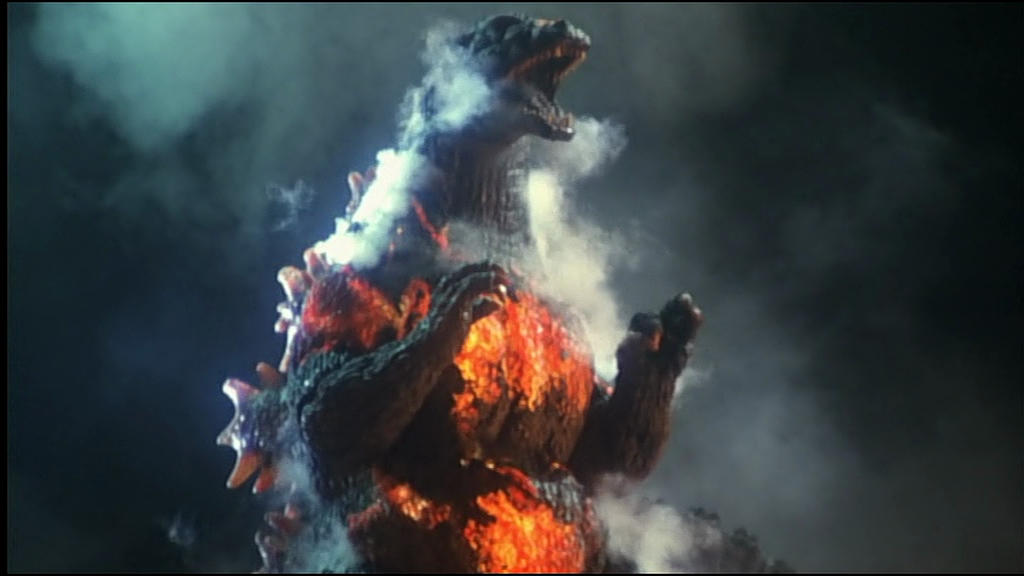
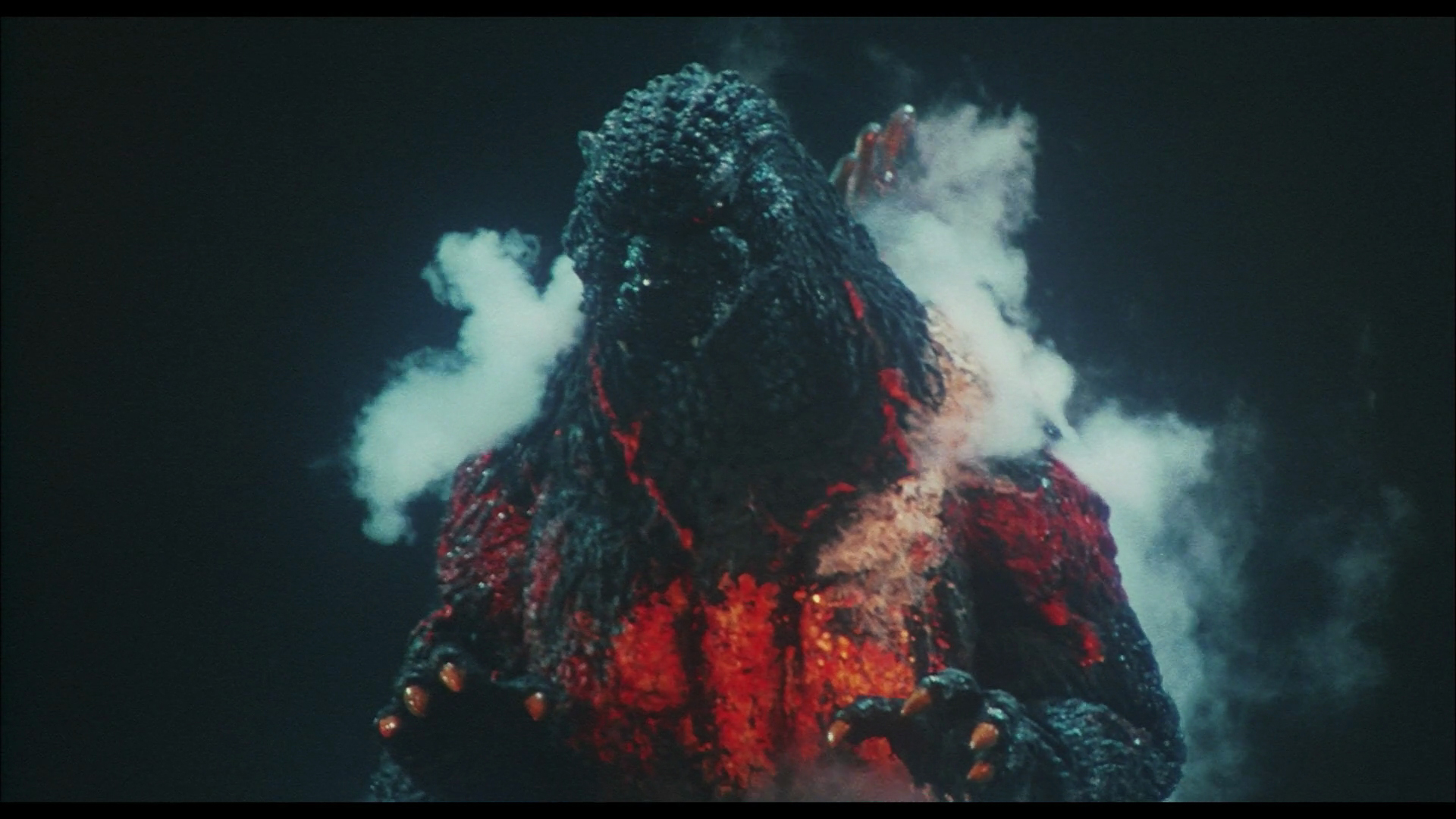 After getting close to his classic status as a reluctant hero in the previous film, Godzilla is reverted back to his destructive ways here, absolutely maddened by the pain of the out of control nuclear energy that's coursing through his body. As shown when he attacks Hong Kong at the beginning of the movie, he's gone completely berserk from his condition, angrily blowing up and smashing everything in his path, as well as at times appearing to have no control over his power, like when he randomly shoots his atomic blast at the water. The crackling sound of the energy coursing through his spines and the wild look in his glowing, red eyes and on his face also help to sell the idea that he's completely lost his mind. As a result of this fragile state of mind, he has no way of getting his power under control and it's going to continue to expand and consume his body until he blows up. He's so out of it and confused that he still tries to go for nuclear reactor, thinking that he needs more nuclear fuel. Everything seems okay after the Super-X III manages to freeze him and reduce his temperature but now, the nuclear fission within his body has taken hold and he's going to eventually meltdown. One thing that's interesting is how his state of mind shifts with his condition. He no longer acts as crazy and insane as he did before, even though it's obvious that he's still in a lot of pain and the approaching meltdown is making it hard for him to control his power, and what's more, he's now intent upon finding and reuniting with Godzilla Junior. You learn that's what he was doing all along but, now that he's coming across as more stable, it seems like he's much more capable of having a pleasant and warm reunion with his adopted son, which I don't think would have been the case if he caught with Junior before. Sure enough, when he enters Tokyo after trailing Junior there, he's much calmer and doesn't intentionally cause any destruction, with his only concern being his desire to reconnect with his son. You can really read Godzilla's emotions in this film. Besides the obvious anger and rage from the pain he's in, you can also tell that he's anxious about finding Junior when he roars for him after entering Tokyo Bay, is excited when they do come together again, and, most touching of all, is absolutely shattered when Destoroyah mortally wounds Junior. When it first happens, Godzilla begins screeching up into the air and, if you look closely, you can see what looks like tears falling from his head, and after he unsuccessfully tries to revive his son with some of his radiation, he slowly stands back up as he realizes that Junior is dead and his grief and anger worsen his condition, causing him to uncontrollably shoot out a blast of energy. Needless to say, he channels all of his anger and building power towards Destoroyah, fighting back against the monster as hard as he can, despite his weakened physical condition. And because of the high stakes, I feel that the decision to allow the military to kill Destoroyah instead of Godzilla was a huge mistake. They really, really should have let him do it and get closure for what happened to his son before he dies. Speaking of which, after Destoroyah is killed, Godzilla doesn't try to go anywhere and he doesn't attack the military or anything else around him. He seems to know that he's about to die and is waiting for it to happen. He suffers a slow and agonizing death but, in a final act of selflessness, he passes his energy on to Junior, reviving him as well as changing him into a powerful adult and, by extension, successor to the throne of King of the Monsters.
After getting close to his classic status as a reluctant hero in the previous film, Godzilla is reverted back to his destructive ways here, absolutely maddened by the pain of the out of control nuclear energy that's coursing through his body. As shown when he attacks Hong Kong at the beginning of the movie, he's gone completely berserk from his condition, angrily blowing up and smashing everything in his path, as well as at times appearing to have no control over his power, like when he randomly shoots his atomic blast at the water. The crackling sound of the energy coursing through his spines and the wild look in his glowing, red eyes and on his face also help to sell the idea that he's completely lost his mind. As a result of this fragile state of mind, he has no way of getting his power under control and it's going to continue to expand and consume his body until he blows up. He's so out of it and confused that he still tries to go for nuclear reactor, thinking that he needs more nuclear fuel. Everything seems okay after the Super-X III manages to freeze him and reduce his temperature but now, the nuclear fission within his body has taken hold and he's going to eventually meltdown. One thing that's interesting is how his state of mind shifts with his condition. He no longer acts as crazy and insane as he did before, even though it's obvious that he's still in a lot of pain and the approaching meltdown is making it hard for him to control his power, and what's more, he's now intent upon finding and reuniting with Godzilla Junior. You learn that's what he was doing all along but, now that he's coming across as more stable, it seems like he's much more capable of having a pleasant and warm reunion with his adopted son, which I don't think would have been the case if he caught with Junior before. Sure enough, when he enters Tokyo after trailing Junior there, he's much calmer and doesn't intentionally cause any destruction, with his only concern being his desire to reconnect with his son. You can really read Godzilla's emotions in this film. Besides the obvious anger and rage from the pain he's in, you can also tell that he's anxious about finding Junior when he roars for him after entering Tokyo Bay, is excited when they do come together again, and, most touching of all, is absolutely shattered when Destoroyah mortally wounds Junior. When it first happens, Godzilla begins screeching up into the air and, if you look closely, you can see what looks like tears falling from his head, and after he unsuccessfully tries to revive his son with some of his radiation, he slowly stands back up as he realizes that Junior is dead and his grief and anger worsen his condition, causing him to uncontrollably shoot out a blast of energy. Needless to say, he channels all of his anger and building power towards Destoroyah, fighting back against the monster as hard as he can, despite his weakened physical condition. And because of the high stakes, I feel that the decision to allow the military to kill Destoroyah instead of Godzilla was a huge mistake. They really, really should have let him do it and get closure for what happened to his son before he dies. Speaking of which, after Destoroyah is killed, Godzilla doesn't try to go anywhere and he doesn't attack the military or anything else around him. He seems to know that he's about to die and is waiting for it to happen. He suffers a slow and agonizing death but, in a final act of selflessness, he passes his energy on to Junior, reviving him as well as changing him into a powerful adult and, by extension, successor to the throne of King of the Monsters. -screenshot.jpg)

 While they kept the same suit that had been used for the previous two movies, the filmmakers visualized the nuclear energy that's consuming Godzilla's body here by having various sections of it, particularly his chest, stomach, and thighs, glow with a fiery orange-red color, his spines take on the same color as well as a flash with a loud crackle at various points, his eyes glow an angry red (the animatronic heads make him look particularly out of his mind with pain due to this effect), and smoke and steam billowing off of him. Instead of being charcoal gray like normal, his unaffected flesh is completely black and you can even see that some of the veins his body, especially those around his neck, are glowing red as well. I think that they created the glowing effects by putting some kind of orange-colored lights within the flesh of the suit, with some matting effects later used to enhance them, and they also constantly pumped the smoke through it, forcing Kenpachiro Satsuma to wear a mask while performing inside it. As the third act progresses and the meltdown nears, you can actually see how Godzilla's condition is deteriorating. Wounds inflicted on him by Destoroyah begin to smoke and cauterize and he starts giving off a greenish glow, which is to say nothing of when his spines begin melting and nuclear energy that's capable of igniting anything it touches pours off of his back. Because of the increase in power, his atomic blast throughout the film is the red-colored super one that he used during the climaxes of the previous two movies and, given the crackling and flashing of his dorsal plates, it constantly seems to be building up within him and forcing him to expel it. His grief upon losing Godzilla Junior only seems to aggravate this condition even more given how there's a flash of energy within him before he shoots it out there. As for his vocalizations, he still has the classic screeching but it's a new, more pained version of it that sounds like he's roaring and groaning at the same time, particularly one where his screech starts out normally but then goes into a deeper, more throaty sound before finishing off like usual. He also gives out some lion-like growls right before he melts down and you can hear him roaring and growling weakly as he dissolves before letting out one final, pained roar before he finally dies. When I first got the Godzilla Compendium, I hadn't seen any of the movies past Godzilla vs. King Ghidorah yet and figured that they would continue on with the more threatening, deep roar that they created in The Return of Godzilla, which actually made feel that I would be able to take his death scene when I finally got around to this movie. However, the use of his classic screeching roar, the one that held more sentimental value to me, with a more pained and weak sound to it to reinforce his condition, made his death all the more personal and affecting for me.
While they kept the same suit that had been used for the previous two movies, the filmmakers visualized the nuclear energy that's consuming Godzilla's body here by having various sections of it, particularly his chest, stomach, and thighs, glow with a fiery orange-red color, his spines take on the same color as well as a flash with a loud crackle at various points, his eyes glow an angry red (the animatronic heads make him look particularly out of his mind with pain due to this effect), and smoke and steam billowing off of him. Instead of being charcoal gray like normal, his unaffected flesh is completely black and you can even see that some of the veins his body, especially those around his neck, are glowing red as well. I think that they created the glowing effects by putting some kind of orange-colored lights within the flesh of the suit, with some matting effects later used to enhance them, and they also constantly pumped the smoke through it, forcing Kenpachiro Satsuma to wear a mask while performing inside it. As the third act progresses and the meltdown nears, you can actually see how Godzilla's condition is deteriorating. Wounds inflicted on him by Destoroyah begin to smoke and cauterize and he starts giving off a greenish glow, which is to say nothing of when his spines begin melting and nuclear energy that's capable of igniting anything it touches pours off of his back. Because of the increase in power, his atomic blast throughout the film is the red-colored super one that he used during the climaxes of the previous two movies and, given the crackling and flashing of his dorsal plates, it constantly seems to be building up within him and forcing him to expel it. His grief upon losing Godzilla Junior only seems to aggravate this condition even more given how there's a flash of energy within him before he shoots it out there. As for his vocalizations, he still has the classic screeching but it's a new, more pained version of it that sounds like he's roaring and groaning at the same time, particularly one where his screech starts out normally but then goes into a deeper, more throaty sound before finishing off like usual. He also gives out some lion-like growls right before he melts down and you can hear him roaring and growling weakly as he dissolves before letting out one final, pained roar before he finally dies. When I first got the Godzilla Compendium, I hadn't seen any of the movies past Godzilla vs. King Ghidorah yet and figured that they would continue on with the more threatening, deep roar that they created in The Return of Godzilla, which actually made feel that I would be able to take his death scene when I finally got around to this movie. However, the use of his classic screeching roar, the one that held more sentimental value to me, with a more pained and weak sound to it to reinforce his condition, made his death all the more personal and affecting for me.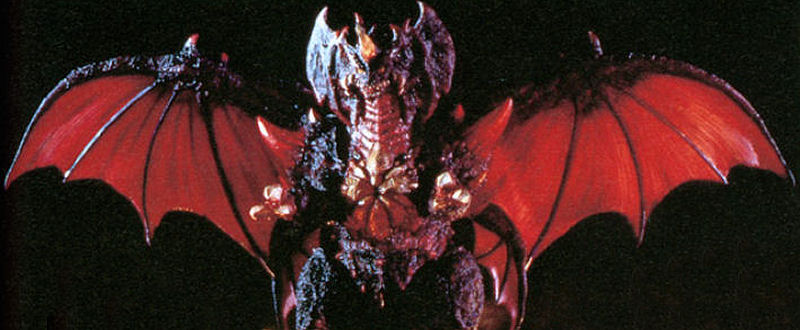 Destoroyah (Ryo Hariya), in all of the various stages of his life cycle, is for the most part simply intent on living up to his name. As soon as the microscopic Precambrian creatures that he starts out as first make themselves known, they disintegrate all of the life in an aquarium and later, when they evolve into their bigger, crab-like forms, they continue to wreak havoc at the bayside development center, causing a lot of property damage and killing many of the JSDF soldiers who arrive to combat them. Their other motivation appears to be feeding off the energy of other life-forms, which is why they attacked the aquarium, and is also possibly what the one Destoroyah was trying to do when he went after Yukari and trapped her in an abandoned police car. These juvenile Destoroyahs are again faced with the military later on and appear to attack them simply out of aggressiveness and to feed off of the energy, rather than defense seeing as how the military didn't actively threaten them after gathering there. But, when they get blasted with a weapon that's capable of disintegrating them, the Destoroyahs, after initially reeling from it, come together and form into one big monster that's able to overwhelm the military. (I'm not sure if this merger is an unexpected side-effect of the military's weapons, which did involve micro-oxygen, or if it was simply a defense mechanism.) This gigantic Destoroyah proceeds to attack Tokyo, causing a lot of damage with his ability to change into a flying form at will, and when Godzilla Junior arrive, he attacks him without any provocation and attempts to inject him with micro-oxygen and drain his energy. Junior, however, manages to seriously wound Destoroyah but he doesn't kill him and because of that, he's able to metamorphose into his ultimate form. Once he's finished with his transformation, Destoroyah's first action is to enact cruel revenge on Junior, blasting Godzilla with his oxygen-destroyer ray, grabbing the younger monster by the throat, fly off with him, and drop him from a great distance before blasting with his ray. Godzilla's following despair and heartbreak over what just happened to his son makes Destoroyah the only opponent that has ever inflicted emotional pain on him. After dispensing with Junior, Destoroyah turns his attention on Godzilla and mercilessly attacks him, now coming across as downright sadistic as well as violent and cruel. Although he does take some major punishment from Godzilla, Destoroyah manages to dish it right back, proving himself to be powerful enough to take the Big G on even when his power is at its peak. He never relents, coming at Godzilla again and again and even separating into his many juvenile states so he can try to overwhelm Godzilla as well as tagging him from behind when he's mourning over his son. Despite his merciless attitude and overall brute force-oriented mindset, Destoroyah is smart enough to recognize when he's outmatched. Near the end of the film when Godzilla's meltdown is only a few minutes away and his power is now unparalleled, Destoroyah realizes that he's going to lose if he continues fighting and attempts to escape, which is when he is shot down and killed by the military's freezer weapons (again, they should have let Godzilla finish him off).
Destoroyah (Ryo Hariya), in all of the various stages of his life cycle, is for the most part simply intent on living up to his name. As soon as the microscopic Precambrian creatures that he starts out as first make themselves known, they disintegrate all of the life in an aquarium and later, when they evolve into their bigger, crab-like forms, they continue to wreak havoc at the bayside development center, causing a lot of property damage and killing many of the JSDF soldiers who arrive to combat them. Their other motivation appears to be feeding off the energy of other life-forms, which is why they attacked the aquarium, and is also possibly what the one Destoroyah was trying to do when he went after Yukari and trapped her in an abandoned police car. These juvenile Destoroyahs are again faced with the military later on and appear to attack them simply out of aggressiveness and to feed off of the energy, rather than defense seeing as how the military didn't actively threaten them after gathering there. But, when they get blasted with a weapon that's capable of disintegrating them, the Destoroyahs, after initially reeling from it, come together and form into one big monster that's able to overwhelm the military. (I'm not sure if this merger is an unexpected side-effect of the military's weapons, which did involve micro-oxygen, or if it was simply a defense mechanism.) This gigantic Destoroyah proceeds to attack Tokyo, causing a lot of damage with his ability to change into a flying form at will, and when Godzilla Junior arrive, he attacks him without any provocation and attempts to inject him with micro-oxygen and drain his energy. Junior, however, manages to seriously wound Destoroyah but he doesn't kill him and because of that, he's able to metamorphose into his ultimate form. Once he's finished with his transformation, Destoroyah's first action is to enact cruel revenge on Junior, blasting Godzilla with his oxygen-destroyer ray, grabbing the younger monster by the throat, fly off with him, and drop him from a great distance before blasting with his ray. Godzilla's following despair and heartbreak over what just happened to his son makes Destoroyah the only opponent that has ever inflicted emotional pain on him. After dispensing with Junior, Destoroyah turns his attention on Godzilla and mercilessly attacks him, now coming across as downright sadistic as well as violent and cruel. Although he does take some major punishment from Godzilla, Destoroyah manages to dish it right back, proving himself to be powerful enough to take the Big G on even when his power is at its peak. He never relents, coming at Godzilla again and again and even separating into his many juvenile states so he can try to overwhelm Godzilla as well as tagging him from behind when he's mourning over his son. Despite his merciless attitude and overall brute force-oriented mindset, Destoroyah is smart enough to recognize when he's outmatched. Near the end of the film when Godzilla's meltdown is only a few minutes away and his power is now unparalleled, Destoroyah realizes that he's going to lose if he continues fighting and attempts to escape, which is when he is shot down and killed by the military's freezer weapons (again, they should have let Godzilla finish him off).



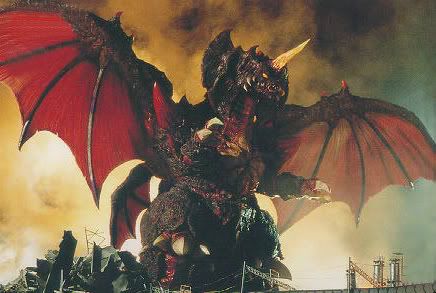 Destoroyah is often cited as being similar to Hedorah, the Smog Monster, since their life-cycles are very similar and they both have weapons capable of disintegrating metal and organic matter. It's a comparison that actually is not unwarranted, especially in the case of their life-cycles, with both of them starting out as millions of microscopic creatures that come together to form one monster, as well as how they both go from living in water to being able to come onto dry land, have a flying form that they can change into at will, and have an ultimate, bipedal form that is bigger than even Godzilla. In the case of Destoroyah, he starts out as millions of microscopic creatures that, when analyzed by Dr. Ijuin's computer, look like tiny horseshoe crabs. These tiny creatures come together to form the juvenile Destoroyahs, which are these man-sized, crustacean monsters that are red in color, have long, leathery necks, very narrow heads with spiny, horn-like formations on either side, mean-looking, yellow segmented eyes, and mouths whose tongues have an extra set of jaws at the end of them (again, a lot like the aliens). While the microscopic creatures had enough power to disintegrate an entire form, these juveniles take it a step further by being able to fire a deadly ray of energy that eats through both flesh and metal. These creatures eventually come together to form what's known as Destoroyah's aggregate form, which is basically just a gigantic version of the juvenile form whose only other differences are a pair of long, spider-like limbs with claws that jut out of either side of its neck (you can see stubs of where they would be on the juveniles), two crab-like claws at the front, and the ability inject a foe with micro-oxygen in order to drain his energy. While in this stage, Destoroyah can change into a flying form that has big, bat-like wings on either side of the body, whose design hints at what the ultimate form will be, with the horn on the forehead, the more typically-shaped mouth, floral pattern on the chest, and the long tail that ends in a curved, barb formation. James Rolfe said it best when he said that Destoroyah's ultimate form, "looks like the goddamn devil!" He really does look very demonic, especially with those enormous, leathery wings on his back in addition to the now longer horn on his forehead, all of the spikes on his body, from his fingertips to his kneecaps, and the glowing yellow eyes that seem to radiate pure evil. Not only does the Micro-Oxygen Ray, which he retained through all of the stages of his life-cycle, remain Destoroyah's main weapon here, albeit much more powerful and devastating (technically, it becomes Oxygen-Destroyer Ray here), but his horn is capable of generating a blade of energy that can slice Godzilla's flesh, his tail's barbed, almost pincer-like, formation is strong enough to grab hold of Godzilla as well as drain and conduct energy, and he can separate back into his juvenile forms in order to swarm over and overwhelm Godzilla. His vocalizations are a number of different raspy snarls and screams, some of which are high-pitched while others sound much deeper and guttural. His aggregate form has a particularly low-pitched howl and his flying form has even lower, reverberating, trumpeting sound. The roar of his ultimate form is, surprisingly, a high-pitched "raaah!" screech, although you can hear a very deep, loud, honking-like noise behind it.
Destoroyah is often cited as being similar to Hedorah, the Smog Monster, since their life-cycles are very similar and they both have weapons capable of disintegrating metal and organic matter. It's a comparison that actually is not unwarranted, especially in the case of their life-cycles, with both of them starting out as millions of microscopic creatures that come together to form one monster, as well as how they both go from living in water to being able to come onto dry land, have a flying form that they can change into at will, and have an ultimate, bipedal form that is bigger than even Godzilla. In the case of Destoroyah, he starts out as millions of microscopic creatures that, when analyzed by Dr. Ijuin's computer, look like tiny horseshoe crabs. These tiny creatures come together to form the juvenile Destoroyahs, which are these man-sized, crustacean monsters that are red in color, have long, leathery necks, very narrow heads with spiny, horn-like formations on either side, mean-looking, yellow segmented eyes, and mouths whose tongues have an extra set of jaws at the end of them (again, a lot like the aliens). While the microscopic creatures had enough power to disintegrate an entire form, these juveniles take it a step further by being able to fire a deadly ray of energy that eats through both flesh and metal. These creatures eventually come together to form what's known as Destoroyah's aggregate form, which is basically just a gigantic version of the juvenile form whose only other differences are a pair of long, spider-like limbs with claws that jut out of either side of its neck (you can see stubs of where they would be on the juveniles), two crab-like claws at the front, and the ability inject a foe with micro-oxygen in order to drain his energy. While in this stage, Destoroyah can change into a flying form that has big, bat-like wings on either side of the body, whose design hints at what the ultimate form will be, with the horn on the forehead, the more typically-shaped mouth, floral pattern on the chest, and the long tail that ends in a curved, barb formation. James Rolfe said it best when he said that Destoroyah's ultimate form, "looks like the goddamn devil!" He really does look very demonic, especially with those enormous, leathery wings on his back in addition to the now longer horn on his forehead, all of the spikes on his body, from his fingertips to his kneecaps, and the glowing yellow eyes that seem to radiate pure evil. Not only does the Micro-Oxygen Ray, which he retained through all of the stages of his life-cycle, remain Destoroyah's main weapon here, albeit much more powerful and devastating (technically, it becomes Oxygen-Destroyer Ray here), but his horn is capable of generating a blade of energy that can slice Godzilla's flesh, his tail's barbed, almost pincer-like, formation is strong enough to grab hold of Godzilla as well as drain and conduct energy, and he can separate back into his juvenile forms in order to swarm over and overwhelm Godzilla. His vocalizations are a number of different raspy snarls and screams, some of which are high-pitched while others sound much deeper and guttural. His aggregate form has a particularly low-pitched howl and his flying form has even lower, reverberating, trumpeting sound. The roar of his ultimate form is, surprisingly, a high-pitched "raaah!" screech, although you can hear a very deep, loud, honking-like noise behind it.
 Little Godzilla, now known as Godzilla Junior (Ryu Hurricane), has certainly changed a lot since we last saw him in Godzilla vs. SpaceGodzilla. Now no longer a chubby, cute, and helpless baby, his father's out of control radioactivity that destroyed Birth Island has turned him into a strong sub-adult who, while not as ferocious as Godzilla, has a lot more tenacity with him given how he apparently killed a bunch of whales and takes on the continuously-changing Destoroyah without any hesitation. However, despite this more ferocious personality, as well as how he doesn't have much actual interaction with her, I get the feeling that Junior does remember Miki Saegusa and still feels a connection with her given how he seems to save her chopper from Destoroyah and also appears to look at her through the window after doing so. Just as you feel sympathy for Godzilla himself, you feel the same for Junior since he hasn't done anything in the wrong in the three movies that he's been in and he just wants to go home but, like before, is used as bait to lure Godzilla to his death, which ultimately results in Junior himself being mortally wounded. It's especially tragic because you can tell that Godzilla and Junior have become very close over the time since they become adopted father and son, with how they call to each other and get really excited when they meet up in Tokyo. It makes you understand Godzilla's rage and pain after Destoroyah mortally wounds him even more and why, during his dying moments, he gives Junior his power so he will revive and live on as the new King of the Monsters. As you can see, Junior's look is basically just that of a younger Godzilla, with a smaller body and dorsal plates, and a less stern, more innocent-looking face. And unlike his father, Junior is actually green. At this point, he has managed to develop an atomic blast and while it's certainly not as powerful as his dad's, he still manages to injure the aggregate Destoroyah with it. And his roar, as you can guess, is just a higher-pitched version of Godzilla's, and he also makes a throaty, groaning howl when he's calling for Godzilla in Tokyo as well as some surprisingly cute, juvenile growls and snarls when he's being directed there in the first place.
Little Godzilla, now known as Godzilla Junior (Ryu Hurricane), has certainly changed a lot since we last saw him in Godzilla vs. SpaceGodzilla. Now no longer a chubby, cute, and helpless baby, his father's out of control radioactivity that destroyed Birth Island has turned him into a strong sub-adult who, while not as ferocious as Godzilla, has a lot more tenacity with him given how he apparently killed a bunch of whales and takes on the continuously-changing Destoroyah without any hesitation. However, despite this more ferocious personality, as well as how he doesn't have much actual interaction with her, I get the feeling that Junior does remember Miki Saegusa and still feels a connection with her given how he seems to save her chopper from Destoroyah and also appears to look at her through the window after doing so. Just as you feel sympathy for Godzilla himself, you feel the same for Junior since he hasn't done anything in the wrong in the three movies that he's been in and he just wants to go home but, like before, is used as bait to lure Godzilla to his death, which ultimately results in Junior himself being mortally wounded. It's especially tragic because you can tell that Godzilla and Junior have become very close over the time since they become adopted father and son, with how they call to each other and get really excited when they meet up in Tokyo. It makes you understand Godzilla's rage and pain after Destoroyah mortally wounds him even more and why, during his dying moments, he gives Junior his power so he will revive and live on as the new King of the Monsters. As you can see, Junior's look is basically just that of a younger Godzilla, with a smaller body and dorsal plates, and a less stern, more innocent-looking face. And unlike his father, Junior is actually green. At this point, he has managed to develop an atomic blast and while it's certainly not as powerful as his dad's, he still manages to injure the aggregate Destoroyah with it. And his roar, as you can guess, is just a higher-pitched version of Godzilla's, and he also makes a throaty, groaning howl when he's calling for Godzilla in Tokyo as well as some surprisingly cute, juvenile growls and snarls when he's being directed there in the first place.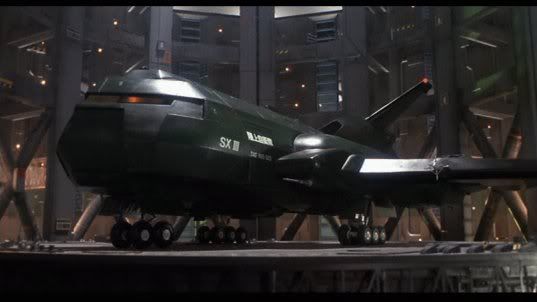 And it wouldn't be the Heisei series if we didn't have some type of advanced military craft thrown into the mix as well, so here we have the Super-X III, the third and final iteration of the craft that first appeared in The Return of Godzilla. Like the original Super-X, this one is actually operated by pilots rather than remote control like second one but is much sleeker and less bulky in design, looking much more like a large, green fighter jet than a flying tank. While its armor is very strong and heat resistant, able to withstand direct hits from Godzilla's super atomic blast, none of its weapons are explosive in nature but, instead, are what are called "freezer weapons" and include missiles capable of creating ice around a target, cadmium missiles, and, most powerful of all, a freezing laser cannon that can freeze something down to -200 degrees. These ultra low-temperature weapons, which, like the original Super-X, were designed to protect Japan against anything involving radiation, be it an accident or attack, managed to be very useful against Godzilla while he was in this state of his power running wild, managing to cool him down and freeze him at one point as well as keep his meltdown from destroying the planet, although they were unable to stop it completely or save Tokyo from the fallout. Notably, the Super-X III is the only "mecha" that appeared in this second series that didn't end up getting destroyed by either Godzilla or, in the case of Moguera, another monster.
And it wouldn't be the Heisei series if we didn't have some type of advanced military craft thrown into the mix as well, so here we have the Super-X III, the third and final iteration of the craft that first appeared in The Return of Godzilla. Like the original Super-X, this one is actually operated by pilots rather than remote control like second one but is much sleeker and less bulky in design, looking much more like a large, green fighter jet than a flying tank. While its armor is very strong and heat resistant, able to withstand direct hits from Godzilla's super atomic blast, none of its weapons are explosive in nature but, instead, are what are called "freezer weapons" and include missiles capable of creating ice around a target, cadmium missiles, and, most powerful of all, a freezing laser cannon that can freeze something down to -200 degrees. These ultra low-temperature weapons, which, like the original Super-X, were designed to protect Japan against anything involving radiation, be it an accident or attack, managed to be very useful against Godzilla while he was in this state of his power running wild, managing to cool him down and freeze him at one point as well as keep his meltdown from destroying the planet, although they were unable to stop it completely or save Tokyo from the fallout. Notably, the Super-X III is the only "mecha" that appeared in this second series that didn't end up getting destroyed by either Godzilla or, in the case of Moguera, another monster.


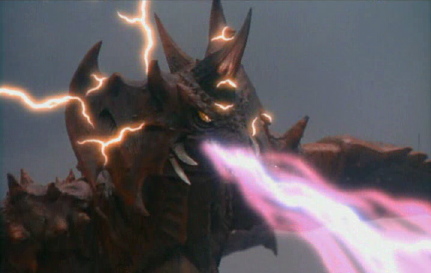
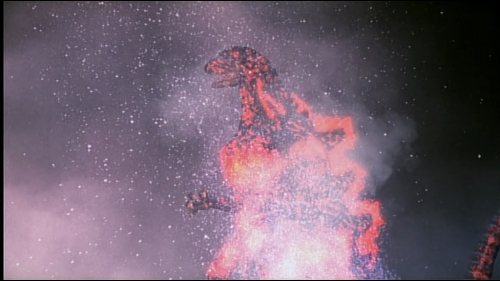 The day before Godzilla vs. Destoroyah was released, Koichi Kawakita announced that he was going to be retiring from his position as the head of Toho's special effects unit. While he would stick around until after the second Rebirth of Mothra movie in 1997 (and would also temporarily return to the field of effects work in 2003 for a science fiction TV show that Toho produced), Destoroyah would mark his final involvement with Godzilla and, like Teruyoshi Nakano before him, he sent himself off with what could quite possibly be the best work he had ever done. The effects in this film are just phenomenal and more than make up for the rather disappointing ones that were featured in the previous film. Except for a tiny moment when Destoroyah is carrying Godzilla Junior by the throat and you can see a string on his hand if you look in the right place, as well as some dodgy CGI during the scene where the JSDF battles the juvenile Destoroyahs at the construction site, I can't think of an effect in the film that looks hokey. Not only do the monsters look phenomenal, with Destoroyah's ultimate form being a knockout, but the effects used to portray the radioactivity that's running wild throughout Godzilla's body and how it's progressing look absolutely convincing and not at all fake. The animatronic heads for the monsters also look great (like I said earlier, the animatronics for Godzilla himself this time around are a little creepy in how completely mad his glowing red eyes make him look), the miniature models created for the juvenile Destoroyahs move in a way similar to stop-motion, creating an eerie scuttling effect that comes across as very insect-like, the miniature buildings and military vehicles are completely believable and well-designed, especially the Super-X III (like before with the previous Super-X's, you can't see a single wire holding that thing up), the pyrotechnics are just as eye-popping as ever, and the matting and rotoscoping effects are so close to perfect, particularly the monsters' energy beams and the dissolving fish in the aquarium, that it's kind of scary. Like, there are some instances of early CGI here, most notably when Godzilla melts down as well as during the amazing opening title, for a brief shot of a military helicopter, and, again, during the battle between the juvenile Destoroyahs and the military. While the latter definitely does look pretty bad (although, that's said, it's filmed in a way where you would have to look very closely at it to notice), most of it does look pretty good. CGI had been used a little bit in the previous Heisei series films, mainly for shots of computer models and readouts that the characters look at, and the use of it here certainly isn't major but it's definitely more present than it was before (and in case you think some of it does look bad, just wait until we get to Godzilla 2000 and some of the other entries in the Millennium series). I can't sum it up any better way than with two words: good stuff.
The day before Godzilla vs. Destoroyah was released, Koichi Kawakita announced that he was going to be retiring from his position as the head of Toho's special effects unit. While he would stick around until after the second Rebirth of Mothra movie in 1997 (and would also temporarily return to the field of effects work in 2003 for a science fiction TV show that Toho produced), Destoroyah would mark his final involvement with Godzilla and, like Teruyoshi Nakano before him, he sent himself off with what could quite possibly be the best work he had ever done. The effects in this film are just phenomenal and more than make up for the rather disappointing ones that were featured in the previous film. Except for a tiny moment when Destoroyah is carrying Godzilla Junior by the throat and you can see a string on his hand if you look in the right place, as well as some dodgy CGI during the scene where the JSDF battles the juvenile Destoroyahs at the construction site, I can't think of an effect in the film that looks hokey. Not only do the monsters look phenomenal, with Destoroyah's ultimate form being a knockout, but the effects used to portray the radioactivity that's running wild throughout Godzilla's body and how it's progressing look absolutely convincing and not at all fake. The animatronic heads for the monsters also look great (like I said earlier, the animatronics for Godzilla himself this time around are a little creepy in how completely mad his glowing red eyes make him look), the miniature models created for the juvenile Destoroyahs move in a way similar to stop-motion, creating an eerie scuttling effect that comes across as very insect-like, the miniature buildings and military vehicles are completely believable and well-designed, especially the Super-X III (like before with the previous Super-X's, you can't see a single wire holding that thing up), the pyrotechnics are just as eye-popping as ever, and the matting and rotoscoping effects are so close to perfect, particularly the monsters' energy beams and the dissolving fish in the aquarium, that it's kind of scary. Like, there are some instances of early CGI here, most notably when Godzilla melts down as well as during the amazing opening title, for a brief shot of a military helicopter, and, again, during the battle between the juvenile Destoroyahs and the military. While the latter definitely does look pretty bad (although, that's said, it's filmed in a way where you would have to look very closely at it to notice), most of it does look pretty good. CGI had been used a little bit in the previous Heisei series films, mainly for shots of computer models and readouts that the characters look at, and the use of it here certainly isn't major but it's definitely more present than it was before (and in case you think some of it does look bad, just wait until we get to Godzilla 2000 and some of the other entries in the Millennium series). I can't sum it up any better way than with two words: good stuff. 

 The film begins with the ominous sound of some thundering footsteps followed by Godzilla's roar (note the similarities to the beginning of the original 1954 film) before we get the opening scene, which is Miki Saegusa flying to Birth Island only to find that it's been destroyed, with only a still-smoldering bit of rock left. We then cut to Hong Kong at sunset and focus on an airport, where a plane takes off as night falls. As soon as they enter the air, a red glow fills the cockpit and the Asian copilot (the captain is American) exclaims that it's a red dragon. Of course, we quickly see that it's Godzilla and the plane just barely misses slamming into his head, banking sharply to the left. Godzilla fires his red atomic blast into the air and creates massive turbulence in the bay as he comes ashore, allowing us to get our first look at his glowing, steaming condition in the process. Roaring in rage and pain, with his dorsal plates crackling with energy, Godzilla begins wreaking complete havoc, plowing through buildings behind the main city skyline, sending people running for cover in terror. He momentarily reenters the bay, continuing to howl and roar, before he shoots his blast into the water and then swinging around and blasting the shoreline, completely blowing that side of the harbor to bits. I normally don't mention the actual title but this one comes up in a really amazing way, showing Godzilla's name in kanji in black and white (again, like the original movie), which then explodes and leads into a shot of a computer-generated Oxygen Destroyer that sends bubbles flying at the screen, dissolving to a shot of the Hong Kong skyline with flames in the foreground as Godzilla's fired up onto the top part of the screen one character at a time, with Destoroyah's name attaching beneath as a VS. appears in-between them. That is just spectacular. After the title, Godzilla continues his rampage, coming back ashore, smashing the side of a building and neon signs, crushing and plowing through some more buildings before blowing up another crisscross of signs in front of him. He steps on and smashes through more buildings and fires his blast again before turning as his dorsal plates once again crackle, as the scene cuts.
The film begins with the ominous sound of some thundering footsteps followed by Godzilla's roar (note the similarities to the beginning of the original 1954 film) before we get the opening scene, which is Miki Saegusa flying to Birth Island only to find that it's been destroyed, with only a still-smoldering bit of rock left. We then cut to Hong Kong at sunset and focus on an airport, where a plane takes off as night falls. As soon as they enter the air, a red glow fills the cockpit and the Asian copilot (the captain is American) exclaims that it's a red dragon. Of course, we quickly see that it's Godzilla and the plane just barely misses slamming into his head, banking sharply to the left. Godzilla fires his red atomic blast into the air and creates massive turbulence in the bay as he comes ashore, allowing us to get our first look at his glowing, steaming condition in the process. Roaring in rage and pain, with his dorsal plates crackling with energy, Godzilla begins wreaking complete havoc, plowing through buildings behind the main city skyline, sending people running for cover in terror. He momentarily reenters the bay, continuing to howl and roar, before he shoots his blast into the water and then swinging around and blasting the shoreline, completely blowing that side of the harbor to bits. I normally don't mention the actual title but this one comes up in a really amazing way, showing Godzilla's name in kanji in black and white (again, like the original movie), which then explodes and leads into a shot of a computer-generated Oxygen Destroyer that sends bubbles flying at the screen, dissolving to a shot of the Hong Kong skyline with flames in the foreground as Godzilla's fired up onto the top part of the screen one character at a time, with Destoroyah's name attaching beneath as a VS. appears in-between them. That is just spectacular. After the title, Godzilla continues his rampage, coming back ashore, smashing the side of a building and neon signs, crushing and plowing through some more buildings before blowing up another crisscross of signs in front of him. He steps on and smashes through more buildings and fires his blast again before turning as his dorsal plates once again crackle, as the scene cuts.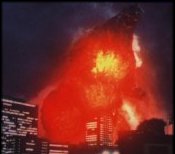
 A number of major character and dialogue scenes follow before we get to the first scene at the development area in Tokyo Bay where it's obvious that something isn't quite wrong. While engineers are studying computer readouts of an unstable stratus, the lights go out and they hear over the intercom that has a shaft has actually begun dissolving. The brief scene ends as the engineers quickly run down to tunnel to figure out what the problem is. Immediately after that, we get a moment in an American command center where a woman technician notes that there's a sudden increase in water temperature of about 60 to 70 degrees Centigrade in the Sea of Taiwan. Cutting to that very location, a research plane discovers that the cause, predictably is Godzilla, whose rampant power is boiling the water around him. After that is the scene where Kenichi announces his theory that Godzilla will most likely eventually blow up with catastrophic results. That's when we get the computer simulation of what that will look like. After he passes behind the Waco and Diet Buildings, Godzilla instantly blows up, with the resulting shockwave spreading through Tokyo and reducing a good portion of it to a roaring, radioactive inferno. All of Godzilla's nuclear energy goes up into the atmosphere and actually appears to be burning a hole through it, before we end on a very ominous shot of the Earth as the radiation begins spreading all over the planet, with the center of it in Japan swelling up and hinting at another explosion. That's followed up with a moment where Dr. Ijuin leaves the tunnel at the bay after taking some soil samples, giving the reporters gathered at the mouth some cryptic answers to their questions, as the film once again slows down for a bit, save for a scene where Ijuin and his colleagues detect signs of life within the soil samples and another where Emiko has a nightmare about the death of the original Godzilla immediately following the moment when Kenichi says that they must recreate the Oxygen Destroyer in order to stop the building explosion (during the shot when the original Godzilla roars in pain from the Oxygen Destroyer's effects, note that it's actually Destoroyah's vocalizations, making for an interesting connection between the two monsters as well as a warning of things to come).
A number of major character and dialogue scenes follow before we get to the first scene at the development area in Tokyo Bay where it's obvious that something isn't quite wrong. While engineers are studying computer readouts of an unstable stratus, the lights go out and they hear over the intercom that has a shaft has actually begun dissolving. The brief scene ends as the engineers quickly run down to tunnel to figure out what the problem is. Immediately after that, we get a moment in an American command center where a woman technician notes that there's a sudden increase in water temperature of about 60 to 70 degrees Centigrade in the Sea of Taiwan. Cutting to that very location, a research plane discovers that the cause, predictably is Godzilla, whose rampant power is boiling the water around him. After that is the scene where Kenichi announces his theory that Godzilla will most likely eventually blow up with catastrophic results. That's when we get the computer simulation of what that will look like. After he passes behind the Waco and Diet Buildings, Godzilla instantly blows up, with the resulting shockwave spreading through Tokyo and reducing a good portion of it to a roaring, radioactive inferno. All of Godzilla's nuclear energy goes up into the atmosphere and actually appears to be burning a hole through it, before we end on a very ominous shot of the Earth as the radiation begins spreading all over the planet, with the center of it in Japan swelling up and hinting at another explosion. That's followed up with a moment where Dr. Ijuin leaves the tunnel at the bay after taking some soil samples, giving the reporters gathered at the mouth some cryptic answers to their questions, as the film once again slows down for a bit, save for a scene where Ijuin and his colleagues detect signs of life within the soil samples and another where Emiko has a nightmare about the death of the original Godzilla immediately following the moment when Kenichi says that they must recreate the Oxygen Destroyer in order to stop the building explosion (during the shot when the original Godzilla roars in pain from the Oxygen Destroyer's effects, note that it's actually Destoroyah's vocalizations, making for an interesting connection between the two monsters as well as a warning of things to come). 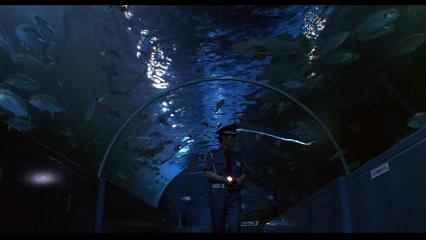




 Following the moment where, after not detecting any more life-signs within the soil samples, Ijuin discovers a hole in one of the sample containers, we get the scene at the aquarium where Destoroyah first makes his presence known. A night watchman there is casually making his rounds, at one point saying, "Yo," to a fish in the exhibit off to his right, when, after walking down some stairs, he hears a low, hissing screech. This catches his attention but when nothing more comes of it, he shrugs it off and continues his rounds. When he passes by some other exhibits, he sees a flash of light within one of them and, after rushing there to see what's going on, he sees the flesh get disintegrated off of a fish until there's nothing left but the skeleton. After the bones drop to the bottom of the tank, the watchman, who is in utter shock at what he just saw, exclaims, "The water ate the fish!" Another flash of light in the next exhibit catches his attention and upon running there, he witnesses the same thing, which causes him to scream in utter horror and we then see that all of the fish in that tank have been reduced to bones. The next day, while Yukari and Kenichi are talking to Ijuin about building a new Oxygen Destroyer, Yukari gets a call on her cellphone about the aquarium and the three of them rush over there. Upon arriving, Ijuin reviews the security cam footage of the disintegration of the fish, while a group of onlookers made up of policemen and other officials watch in amazement and shock (I can't believe they're allowing that poor watchman to view it as well). After rewinding and fast-forwarding it many times, Ijuin suggests that they put the tape through a pictorial analysis back at his lab. Upon doing so, they're able to scan a small red dot that streaks in front of the disintegrating fish in the footage and, after creating a 3-D model of it, reveal it to be a very small crustacean-like creature, further astonishing the officials. Ijuin explains that this is the cause of the trouble at the undersea tunnel, that they're a life-form that existed in the ocean stratum during the Precambrian era, causing it to have no oxygen during that period. When the Oxygen Destroyer was detonated in 1954, they were released from the stratum and have been evolving abnormally due to its effects. Ijuin then shows them the hole the creatures burned through in one of the soil-sample containers and says that they thrive on micro-oxygen destruction. A cut shows us that Godzilla has appeared near Okinawa and is heading north back to Japan, while his movements are closely monitored by the Navy and Coast Guard. Upon hearing this, G-Force deploys some patrol units, while Commander Aso, Prof. Fukazawa, and Meru Ozawa wondering why he's coming back to Japan. At the same time, Miki Saegusa is researching reports of whales being killed, feeling that it might be a trail left behind by Little Godzilla, who may have gone through some changes of his own as a result of the destruction of Birth Island. Miki flies out to sea to try to find Little Godzilla again but, after she's unable to sense anything, wonders if he is, in fact, dead.
Following the moment where, after not detecting any more life-signs within the soil samples, Ijuin discovers a hole in one of the sample containers, we get the scene at the aquarium where Destoroyah first makes his presence known. A night watchman there is casually making his rounds, at one point saying, "Yo," to a fish in the exhibit off to his right, when, after walking down some stairs, he hears a low, hissing screech. This catches his attention but when nothing more comes of it, he shrugs it off and continues his rounds. When he passes by some other exhibits, he sees a flash of light within one of them and, after rushing there to see what's going on, he sees the flesh get disintegrated off of a fish until there's nothing left but the skeleton. After the bones drop to the bottom of the tank, the watchman, who is in utter shock at what he just saw, exclaims, "The water ate the fish!" Another flash of light in the next exhibit catches his attention and upon running there, he witnesses the same thing, which causes him to scream in utter horror and we then see that all of the fish in that tank have been reduced to bones. The next day, while Yukari and Kenichi are talking to Ijuin about building a new Oxygen Destroyer, Yukari gets a call on her cellphone about the aquarium and the three of them rush over there. Upon arriving, Ijuin reviews the security cam footage of the disintegration of the fish, while a group of onlookers made up of policemen and other officials watch in amazement and shock (I can't believe they're allowing that poor watchman to view it as well). After rewinding and fast-forwarding it many times, Ijuin suggests that they put the tape through a pictorial analysis back at his lab. Upon doing so, they're able to scan a small red dot that streaks in front of the disintegrating fish in the footage and, after creating a 3-D model of it, reveal it to be a very small crustacean-like creature, further astonishing the officials. Ijuin explains that this is the cause of the trouble at the undersea tunnel, that they're a life-form that existed in the ocean stratum during the Precambrian era, causing it to have no oxygen during that period. When the Oxygen Destroyer was detonated in 1954, they were released from the stratum and have been evolving abnormally due to its effects. Ijuin then shows them the hole the creatures burned through in one of the soil-sample containers and says that they thrive on micro-oxygen destruction. A cut shows us that Godzilla has appeared near Okinawa and is heading north back to Japan, while his movements are closely monitored by the Navy and Coast Guard. Upon hearing this, G-Force deploys some patrol units, while Commander Aso, Prof. Fukazawa, and Meru Ozawa wondering why he's coming back to Japan. At the same time, Miki Saegusa is researching reports of whales being killed, feeling that it might be a trail left behind by Little Godzilla, who may have gone through some changes of his own as a result of the destruction of Birth Island. Miki flies out to sea to try to find Little Godzilla again but, after she's unable to sense anything, wonders if he is, in fact, dead.

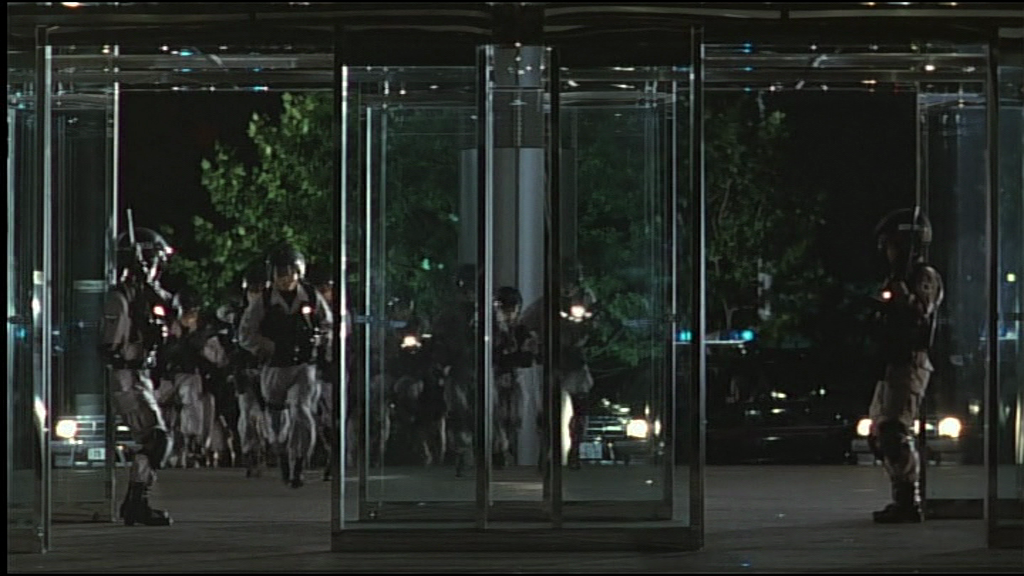
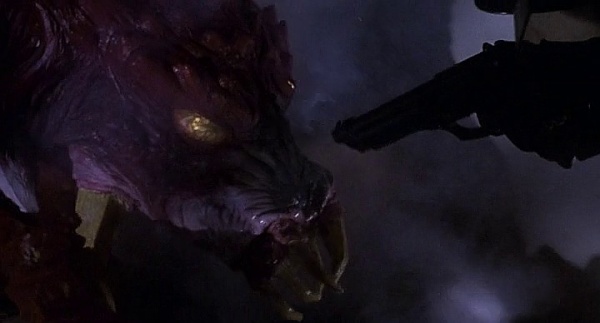
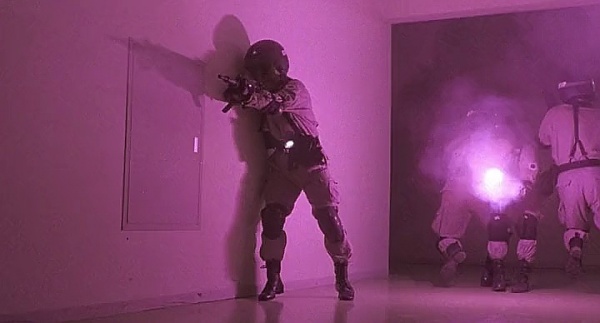 That night in Tokyo, the rapidly evolving Destoroyahs cause a major disturbance at the seaside development area, destroying a nearby overpass as they head towards the abandoned Premium Building there. A special task force of the JSDF is sent to find out what's going on, arriving at the site right after a number of police squad cars and television reporters. One squadron heads to the main entrance, with the police having to force the myriad of reporters out of the way to make room for the vehicles. Upon arriving, they disembark and grab their weapons from the back of the van, while another squadron heads down into the underground garage entrance and does the same. Up top, the first squadron enters the building, splitting up into two groups, with one heading off to the left while the other heads up the escalator to an upper floor. The second squadron down below does the same upon entering the boiler room there and begin scouring the corridors, with their weapons at the ready. This is the sequence that feels like a rip-off of Aliens, down to the way these soldiers are dressed and the way their weapons, which have motion detectors, are designed, with one weapon that we see a soldier cock in different directions looking very much like the advanced rifles seen in that film. During a shot where the camera looks down at the soldiers from above some pipes in the ceiling, we see a Destoroyah's tail in the foreground that slowly slides across as the creature moves when the soldiers get too close. After a rather creepy shot of the monster's face reflected in a shiny piece of equipment, one soldier in a group in a nearby hallway detects something rapidly approaching them. A Destoroyah explodes down through the ceiling and lands in the midst of them, grabbing one soldier behind him with his tail and lifting him up. One of the soldiers reports the creature's appearance and location to the other squadrons as the Destoroyah flings the guy he had attached to his tail to the ground. The others fire on the monster who, after evilly narrowing his eyes at them, fires his Micro-Oxygen Ray, hitting one soldier in the chest and sending him flying through a nearby window. The rest of the squadron heads to the location while the remaining soldiers there continue firing on the Destoroyah as he advances on them down the hall, cornering one guy who proceeds to shoot him in the face. Heading up a nearby flight of stairs, the rest of the soldiers are blindsided when another Destoroyah explodes through the wall behind them and sends them flying, one of which falls over the guardrail. One soldier finds himself trapped on the stairs between that Destoroyah and the other one that cornered the one guy. He futilely fires at the one at the bottom of the stairs before both of them hit him with their Micro-Oxygen Rays. Another Destoroyah smashes through a wall down in the boiler room, forcing the soldiers there to fall back while firing at him. One soldier falls back around a corner but gets jumped from behind by another Destoroyah, who proceeds to trample on him with his many legs.
That night in Tokyo, the rapidly evolving Destoroyahs cause a major disturbance at the seaside development area, destroying a nearby overpass as they head towards the abandoned Premium Building there. A special task force of the JSDF is sent to find out what's going on, arriving at the site right after a number of police squad cars and television reporters. One squadron heads to the main entrance, with the police having to force the myriad of reporters out of the way to make room for the vehicles. Upon arriving, they disembark and grab their weapons from the back of the van, while another squadron heads down into the underground garage entrance and does the same. Up top, the first squadron enters the building, splitting up into two groups, with one heading off to the left while the other heads up the escalator to an upper floor. The second squadron down below does the same upon entering the boiler room there and begin scouring the corridors, with their weapons at the ready. This is the sequence that feels like a rip-off of Aliens, down to the way these soldiers are dressed and the way their weapons, which have motion detectors, are designed, with one weapon that we see a soldier cock in different directions looking very much like the advanced rifles seen in that film. During a shot where the camera looks down at the soldiers from above some pipes in the ceiling, we see a Destoroyah's tail in the foreground that slowly slides across as the creature moves when the soldiers get too close. After a rather creepy shot of the monster's face reflected in a shiny piece of equipment, one soldier in a group in a nearby hallway detects something rapidly approaching them. A Destoroyah explodes down through the ceiling and lands in the midst of them, grabbing one soldier behind him with his tail and lifting him up. One of the soldiers reports the creature's appearance and location to the other squadrons as the Destoroyah flings the guy he had attached to his tail to the ground. The others fire on the monster who, after evilly narrowing his eyes at them, fires his Micro-Oxygen Ray, hitting one soldier in the chest and sending him flying through a nearby window. The rest of the squadron heads to the location while the remaining soldiers there continue firing on the Destoroyah as he advances on them down the hall, cornering one guy who proceeds to shoot him in the face. Heading up a nearby flight of stairs, the rest of the soldiers are blindsided when another Destoroyah explodes through the wall behind them and sends them flying, one of which falls over the guardrail. One soldier finds himself trapped on the stairs between that Destoroyah and the other one that cornered the one guy. He futilely fires at the one at the bottom of the stairs before both of them hit him with their Micro-Oxygen Rays. Another Destoroyah smashes through a wall down in the boiler room, forcing the soldiers there to fall back while firing at him. One soldier falls back around a corner but gets jumped from behind by another Destoroyah, who proceeds to trample on him with his many legs. 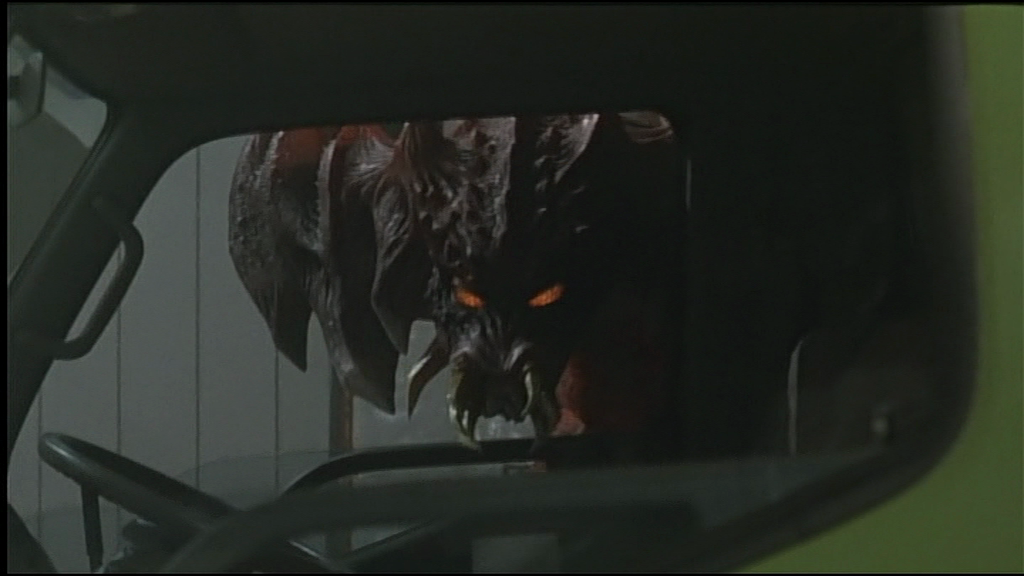
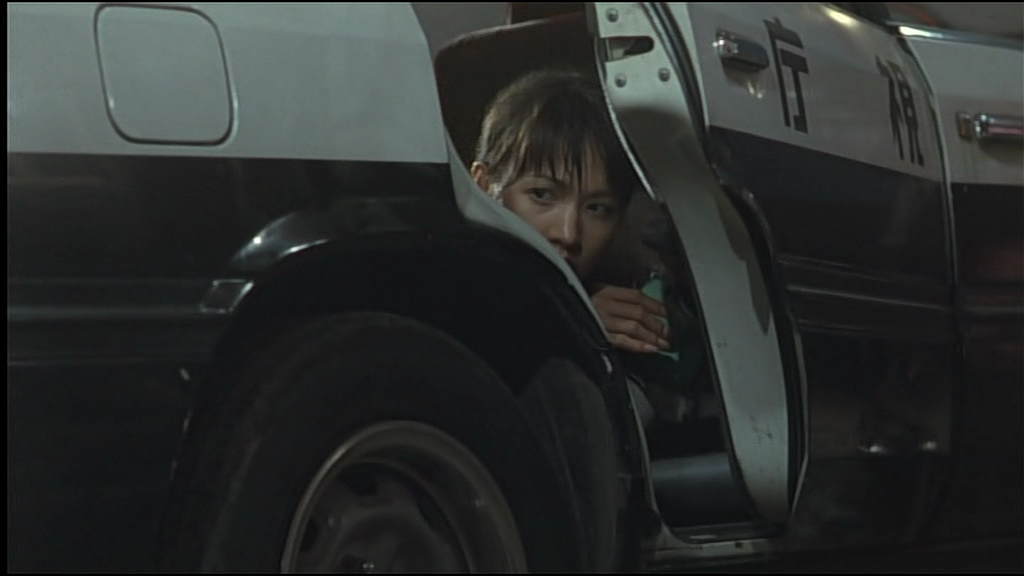

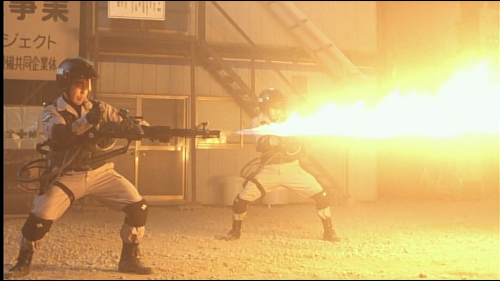 As the Destoroyah stalks through the construction site, Yukari quickly runs from the one side of the tractor she was hiding behind and takes cover inside the back seat of an abandoned squad car. While the rest of the reporters make it out of the site, Yukari's cameraman runs into Ijuin, who asks where Yukari is. The cameraman says that he's not sure since he lost track of her in the chaos and confusion. Ijuin then runs for the site, while Yukari tries to slip out of the back of the squad car and make it to safety. But, before she can get out, the Destoroyah appears and grabs the side of the door with his claw, preventing her closing it. She does tries to close the door but the Destoroyah manages to rip it off, forcing her to move to the other side of the backseat. The Destoroyah then climbs up onto the roof of the car and begins smashing at it with his claws, causing it to cave-in around the driver's side and smash all the windows. Yukari takes cover from the shattering glass and is forced to crawl to the now-cramped front seat when the Destoroyah hooks his claw around the shattered back window. Seeing that they keys are still in the ignition, Yukari starts the car and attempts to drive away but the Destoroyah manages to plant his legs on the ground while keeping his body on the roof, preventing the car from moving. One of his claws then grabs the side of the door on the driver's side and Yukari has to crawl to the passenger side as that door is torn off. The Destoroyah then tears off that seat with his mouth and stretches his long neck, trying to get at Yukari. When he can't quite fit inside to reach her, he tries to use the second set of jaws at the end of his tongue to reach her but that doesn't work either. He growls and snarls before pulling his head back out and screeching in frustration. In his anger, he manages to turn the car over on its roof and then, actually scuttles up to it and flips it back to right-side up. Once that's done, he charges up his Micro-Oxygen Ray and fires it full blast at the car, with Yukari diving back into the backseat to avoid. After shielding herself from the blast, Yukari pulls her hands down to see that the entire middle of the car has been completely dissolved. The Destoroyah then advances on her as she backs away from him, threatening her with his tongue again and a spark of energy within that second set of jaws. Right as the Destoroyah lunges at Yukari, she's pulled through back of the car by Ijuin and the two of them run for it as the monster forces the two remaining halves of the car away from each other. They run off to the side as the Destoroyah gives chase but two flamethrower-wielding soldiers put a stop to that when they blast him until he's completely engulfed. The scene ends on an eerie note as we're shown shots of the dying Destoroyah's melting flesh falling to the ground in flaming bits.
As the Destoroyah stalks through the construction site, Yukari quickly runs from the one side of the tractor she was hiding behind and takes cover inside the back seat of an abandoned squad car. While the rest of the reporters make it out of the site, Yukari's cameraman runs into Ijuin, who asks where Yukari is. The cameraman says that he's not sure since he lost track of her in the chaos and confusion. Ijuin then runs for the site, while Yukari tries to slip out of the back of the squad car and make it to safety. But, before she can get out, the Destoroyah appears and grabs the side of the door with his claw, preventing her closing it. She does tries to close the door but the Destoroyah manages to rip it off, forcing her to move to the other side of the backseat. The Destoroyah then climbs up onto the roof of the car and begins smashing at it with his claws, causing it to cave-in around the driver's side and smash all the windows. Yukari takes cover from the shattering glass and is forced to crawl to the now-cramped front seat when the Destoroyah hooks his claw around the shattered back window. Seeing that they keys are still in the ignition, Yukari starts the car and attempts to drive away but the Destoroyah manages to plant his legs on the ground while keeping his body on the roof, preventing the car from moving. One of his claws then grabs the side of the door on the driver's side and Yukari has to crawl to the passenger side as that door is torn off. The Destoroyah then tears off that seat with his mouth and stretches his long neck, trying to get at Yukari. When he can't quite fit inside to reach her, he tries to use the second set of jaws at the end of his tongue to reach her but that doesn't work either. He growls and snarls before pulling his head back out and screeching in frustration. In his anger, he manages to turn the car over on its roof and then, actually scuttles up to it and flips it back to right-side up. Once that's done, he charges up his Micro-Oxygen Ray and fires it full blast at the car, with Yukari diving back into the backseat to avoid. After shielding herself from the blast, Yukari pulls her hands down to see that the entire middle of the car has been completely dissolved. The Destoroyah then advances on her as she backs away from him, threatening her with his tongue again and a spark of energy within that second set of jaws. Right as the Destoroyah lunges at Yukari, she's pulled through back of the car by Ijuin and the two of them run for it as the monster forces the two remaining halves of the car away from each other. They run off to the side as the Destoroyah gives chase but two flamethrower-wielding soldiers put a stop to that when they blast him until he's completely engulfed. The scene ends on an eerie note as we're shown shots of the dying Destoroyah's melting flesh falling to the ground in flaming bits.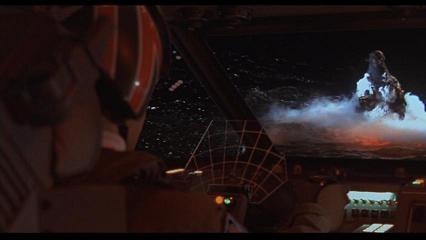
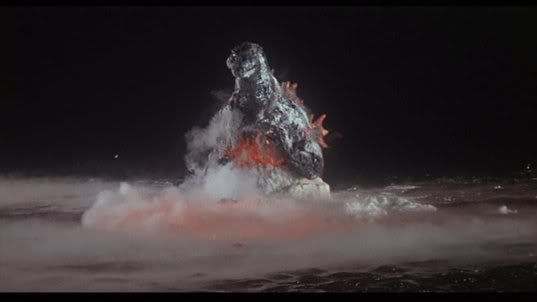
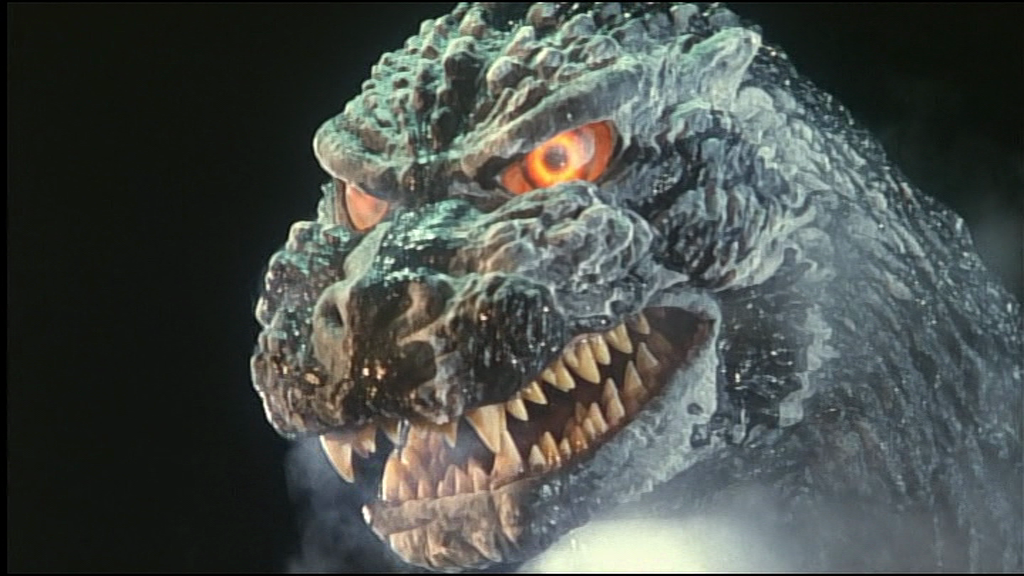

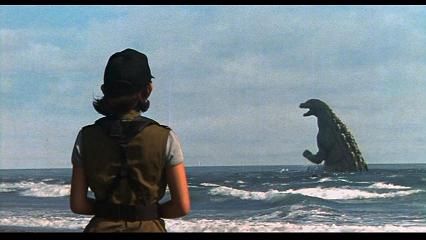 Close to six hours later, with the time almost up, Prof. Fukazawa says he hopes Godzilla doesn't go further up the channel. They then get a report from an American satellite imaging center that the water temperature in the channel is beginning to rapidly rise due to Godzilla's internal nuclear fission. Godzilla begins to move again but, to everyone's surprise, it's away from the reactor. Kenichi then tells them that Godzilla's nuclear fission is beginning to drop due to the cadmium and that it looks like the explosion has been avoided. Following a report from Yukari about the JSDF has temporarily managed to stop the Destoroyahs' rampage as well as a scene where Ijuin discovers a method to liquidize the monsters, the film cuts to a quiet day at the beach that quickly turns to terror for everyone there. Following a loud, booming sound that causes vibrations strong enough to make a sandcastle crumble, Little Godzilla, now having been turned into Godzilla Junior, emerges from the water, causing everyone to panic. Upon either hearing of this or sensing it, Miki arrives in a G-Force helicopter and smiles happily upon realizing that the little one is indeed alive and well. As she watches him wade along the beach, another helicopter sends images of Godzilla Junior to the command center, with Commander Aso commenting that he's not Little Godzilla anymore and actually gives him the name of Junior. They then realize that Godzilla himself has been following Junior this whole time and Miki, upon seeing Junior turn north, informs the command center that he must be heading back to Adona Island in the Bering Sea, where his egg was found two films previously. Therefore, Godzilla is heading that way too. Just then, Meru Ozawa arrives with a grave report from the G-Summit in America, telling everyone that Godzilla's heart has reached a temperature of 900 degrees. Upon hearing this, Kenichi realizes that the nuclear fission within Godzilla is taking control and is raising his body temperature to dangerous levels. That's when he theorizes that Godzilla will eventually meltdown, becoming a flaming ball that would be followed by a hydrogen explosion that will burn right through the Earth's core, like an extreme case of the China Syndrome. We're shown another computer simulation of what this will look like, with a ball of energy sucking down the center of the Earth and dragging everything with it. Kenichi says that the meltdown will occur if Godzilla's temperature reaches 1200 degrees and since his temperature is rising anywhere from 50 to 60 degrees a day, it seems like he'll meltdown within a week.
Close to six hours later, with the time almost up, Prof. Fukazawa says he hopes Godzilla doesn't go further up the channel. They then get a report from an American satellite imaging center that the water temperature in the channel is beginning to rapidly rise due to Godzilla's internal nuclear fission. Godzilla begins to move again but, to everyone's surprise, it's away from the reactor. Kenichi then tells them that Godzilla's nuclear fission is beginning to drop due to the cadmium and that it looks like the explosion has been avoided. Following a report from Yukari about the JSDF has temporarily managed to stop the Destoroyahs' rampage as well as a scene where Ijuin discovers a method to liquidize the monsters, the film cuts to a quiet day at the beach that quickly turns to terror for everyone there. Following a loud, booming sound that causes vibrations strong enough to make a sandcastle crumble, Little Godzilla, now having been turned into Godzilla Junior, emerges from the water, causing everyone to panic. Upon either hearing of this or sensing it, Miki arrives in a G-Force helicopter and smiles happily upon realizing that the little one is indeed alive and well. As she watches him wade along the beach, another helicopter sends images of Godzilla Junior to the command center, with Commander Aso commenting that he's not Little Godzilla anymore and actually gives him the name of Junior. They then realize that Godzilla himself has been following Junior this whole time and Miki, upon seeing Junior turn north, informs the command center that he must be heading back to Adona Island in the Bering Sea, where his egg was found two films previously. Therefore, Godzilla is heading that way too. Just then, Meru Ozawa arrives with a grave report from the G-Summit in America, telling everyone that Godzilla's heart has reached a temperature of 900 degrees. Upon hearing this, Kenichi realizes that the nuclear fission within Godzilla is taking control and is raising his body temperature to dangerous levels. That's when he theorizes that Godzilla will eventually meltdown, becoming a flaming ball that would be followed by a hydrogen explosion that will burn right through the Earth's core, like an extreme case of the China Syndrome. We're shown another computer simulation of what this will look like, with a ball of energy sucking down the center of the Earth and dragging everything with it. Kenichi says that the meltdown will occur if Godzilla's temperature reaches 1200 degrees and since his temperature is rising anywhere from 50 to 60 degrees a day, it seems like he'll meltdown within a week.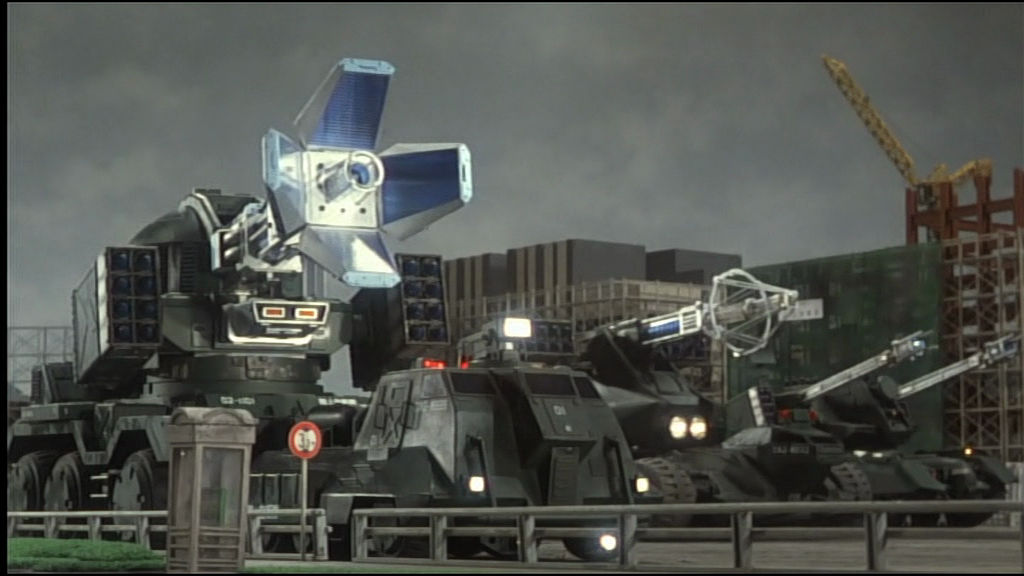


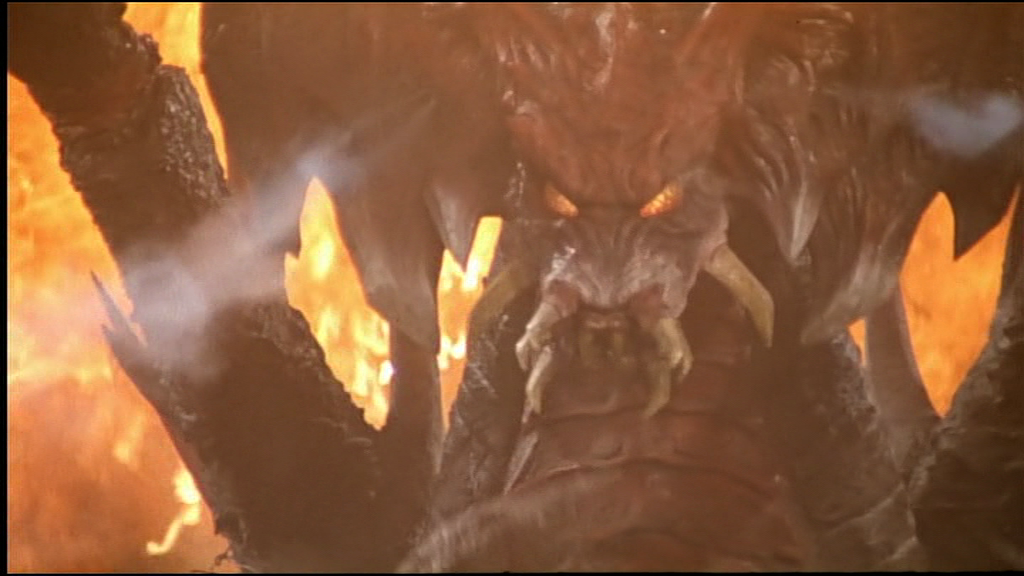
 Some time later in Tokyo, Yukari reports from her news chopper about a military plan to use the super-cold lasers to kill the Destoroyahs. After having sealed off the seaside development area, the military moves in with a number of freezer maser cannons, with tanks and choppers acting as backup while Ijuin, the army commander, and the officials watch from a safe vantage point nearby. Once the machinery and troops are in place, they wait for the Destoroyahs to appear. The creatures don't make them wait long, exploding up out of the ground and the nearby bay to attack. Everyone is told to get ready as the Destoroyahs scuttle towards them from the construction site and once they're within range, the military begins the attack with the freezer lasers. A thunderstorm begins soaking the scene in rain as the Destoroyahs are fired upon all over the construction site by freezer lasers and missiles. They take direct hits from the weapons and fall over to their sides from the impacts, finally scuttling backwards into the site once the armored units begin firing on them. But, just as the commander and Ijuin are confident that they've succeeded, they're told that more creatures are appearing and advancing on the area, with the density of the micro-oxygen rising to the point where it's impossible to measure. That's when, in an explosion of energy, the creatures come together to form one enormous monster, which bellows loudly upon having been created and destroys a structure in the process. As he advances behind a nearby overpass, Destoroyah is fired upon again by the freezer weapons but they do nothing to stop the enormous monster, who retaliates by firing a powerful Oxygen-Destroyer Ray that blows up the overpass he's standing behind. He then advances through the construction site towards the attack vehicles, which continue firing on him until he very easily blows them up with his powerful ray. As the monster creates a series of huge explosions that completely decimates everything in his path, Ijuin realizes that micro-oxygen doesn't have that kind of power and realizes that it's the Oxygen Destroyer, finally giving the monster his name. After moving forward and destroying most of the remaining attack vehicles in his path, Destoroyah changes into his flying form and takes to the sky from the center of the enormous fireball he's created, bellowing all the way. As everyone in the command center watches this, Kenichi announces that Destoroyah is the only thing that can stop Godzilla's meltdown and that the two of them must be brought together to fight. Agreeing with Kenichi, Ozawa suggests using Godzilla Junior to lure Godzilla himself to Tokyo. Despite Miki's protests, Ozawa heads out to put the plan into motion, with Miki reluctantly deciding to go with her. With the final hour now quickly approaching, Fukazawa tells Aso that he'd better warn everyone within 200 kilometers of Tokyo to evacuate to the shelters.
Some time later in Tokyo, Yukari reports from her news chopper about a military plan to use the super-cold lasers to kill the Destoroyahs. After having sealed off the seaside development area, the military moves in with a number of freezer maser cannons, with tanks and choppers acting as backup while Ijuin, the army commander, and the officials watch from a safe vantage point nearby. Once the machinery and troops are in place, they wait for the Destoroyahs to appear. The creatures don't make them wait long, exploding up out of the ground and the nearby bay to attack. Everyone is told to get ready as the Destoroyahs scuttle towards them from the construction site and once they're within range, the military begins the attack with the freezer lasers. A thunderstorm begins soaking the scene in rain as the Destoroyahs are fired upon all over the construction site by freezer lasers and missiles. They take direct hits from the weapons and fall over to their sides from the impacts, finally scuttling backwards into the site once the armored units begin firing on them. But, just as the commander and Ijuin are confident that they've succeeded, they're told that more creatures are appearing and advancing on the area, with the density of the micro-oxygen rising to the point where it's impossible to measure. That's when, in an explosion of energy, the creatures come together to form one enormous monster, which bellows loudly upon having been created and destroys a structure in the process. As he advances behind a nearby overpass, Destoroyah is fired upon again by the freezer weapons but they do nothing to stop the enormous monster, who retaliates by firing a powerful Oxygen-Destroyer Ray that blows up the overpass he's standing behind. He then advances through the construction site towards the attack vehicles, which continue firing on him until he very easily blows them up with his powerful ray. As the monster creates a series of huge explosions that completely decimates everything in his path, Ijuin realizes that micro-oxygen doesn't have that kind of power and realizes that it's the Oxygen Destroyer, finally giving the monster his name. After moving forward and destroying most of the remaining attack vehicles in his path, Destoroyah changes into his flying form and takes to the sky from the center of the enormous fireball he's created, bellowing all the way. As everyone in the command center watches this, Kenichi announces that Destoroyah is the only thing that can stop Godzilla's meltdown and that the two of them must be brought together to fight. Agreeing with Kenichi, Ozawa suggests using Godzilla Junior to lure Godzilla himself to Tokyo. Despite Miki's protests, Ozawa heads out to put the plan into motion, with Miki reluctantly deciding to go with her. With the final hour now quickly approaching, Fukazawa tells Aso that he'd better warn everyone within 200 kilometers of Tokyo to evacuate to the shelters.
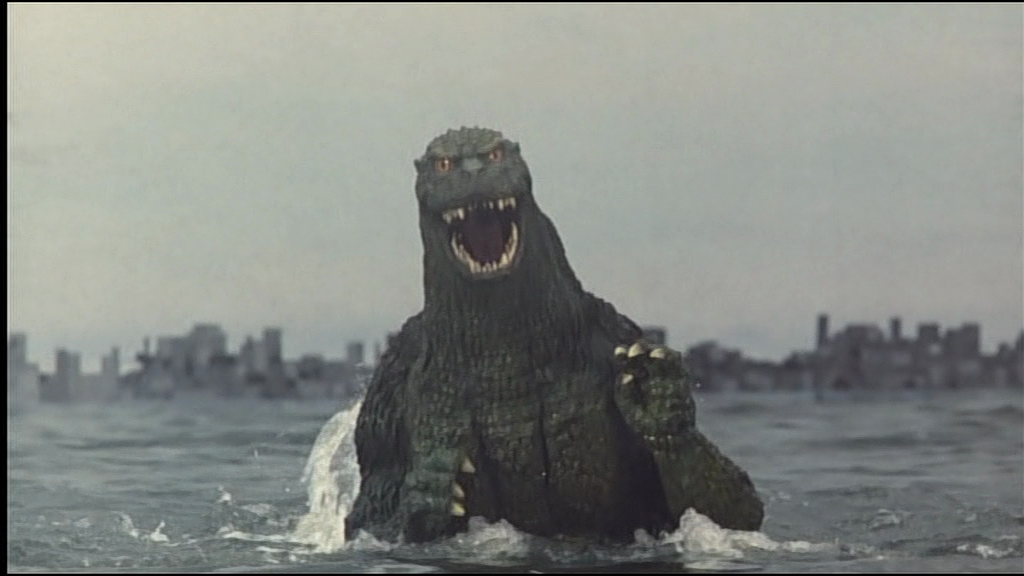



 Flying out to Junior's current position, Ozawa begins concentrating with her psychic powers and, while doing so, takes Miki's hand while she's sitting right beside her. Miki then reluctantly joins her in psychic concentration and their combined efforts manage to make Junior turn around and begin heading for Tokyo, where Destoroyah is causing all sorts of destruction and panic in his flying form. He flies over the city and leave a trail of explosions in his wake, sending people running for their lives (I like how in this one shot, these people on a balcony are just casually watching him blow stuff up as if they're watching a parade!) As he makes several passes over the city, destroying more buildings and causing more panic, Junior arrives in Tokyo Bay, still being guided by Miki and Ozawa. As he approaches, it almost looks like Junior can sense that something is wrong and wants to help. Destoroyah continues his rampage, causing more property damage and sending more people running like scared rabbits, at one point flying directly over a monorail. Junior comes ashore at an industrial complex and unintentionally causes a little bit of destruction as well, while Destoroyah flies over a plaza and sends more people running as he causes more destruction. Junior reaches the edge of the industrial complex and enters the actual city limits right when Destoroyah, sensing an opponent, swings around and knocks him to the ground, following that up with several Oxygen-Destroyer Rays that hit both Junior's body and the building he fell next to, the top half of which collapses right near him. It doesn't bury him completely but it's also obvious that it didn't help his injured condition either. Circling the site, Destoroyah turns his attention to Miki and Ozawa's G-Force helicopter, who've been flying around in order to keep tabs on Junior. Destoroyah chases after them and, since there's no way they can outfly him, he just about catches them. That's when Junior rises up out of the rubble and blasts Destoroyah with his own atomic blast, which is strong enough to send him crashing to the ground, with Junior giving him another taste of it as he does so. Junior then watches as Destoroyah changes back into his aggregate form and the two of them faceoff. Junior manages to smack Destoroyah's head with the side of his own but Destoroyah blasts him with the oxygen ray head on, forcing him back. When Junior turns around to try to get out of the ray's range, Destoroyah blasts him in the back of the head, causing him to crash through the side of a building. Destoroyah continues blasting him as he lays helpless on his side and when Junior manages to get up on his other side, Destoroyah blasts the building directly behind him, causing the top half to collapse onto him. Destoroyah follows that up by jumping up into the air and landing directly on top of Junior before proceeding to mercilessly pound him with his long pair of claws. After getting knocked around for quite a bit, Junior blasts Destoroyah at point-blank range and actually blows off his claws as well as most of the building next to them. As she and Ozawa watch the battle, Miki suddenly senses something: Godzilla is here.
Flying out to Junior's current position, Ozawa begins concentrating with her psychic powers and, while doing so, takes Miki's hand while she's sitting right beside her. Miki then reluctantly joins her in psychic concentration and their combined efforts manage to make Junior turn around and begin heading for Tokyo, where Destoroyah is causing all sorts of destruction and panic in his flying form. He flies over the city and leave a trail of explosions in his wake, sending people running for their lives (I like how in this one shot, these people on a balcony are just casually watching him blow stuff up as if they're watching a parade!) As he makes several passes over the city, destroying more buildings and causing more panic, Junior arrives in Tokyo Bay, still being guided by Miki and Ozawa. As he approaches, it almost looks like Junior can sense that something is wrong and wants to help. Destoroyah continues his rampage, causing more property damage and sending more people running like scared rabbits, at one point flying directly over a monorail. Junior comes ashore at an industrial complex and unintentionally causes a little bit of destruction as well, while Destoroyah flies over a plaza and sends more people running as he causes more destruction. Junior reaches the edge of the industrial complex and enters the actual city limits right when Destoroyah, sensing an opponent, swings around and knocks him to the ground, following that up with several Oxygen-Destroyer Rays that hit both Junior's body and the building he fell next to, the top half of which collapses right near him. It doesn't bury him completely but it's also obvious that it didn't help his injured condition either. Circling the site, Destoroyah turns his attention to Miki and Ozawa's G-Force helicopter, who've been flying around in order to keep tabs on Junior. Destoroyah chases after them and, since there's no way they can outfly him, he just about catches them. That's when Junior rises up out of the rubble and blasts Destoroyah with his own atomic blast, which is strong enough to send him crashing to the ground, with Junior giving him another taste of it as he does so. Junior then watches as Destoroyah changes back into his aggregate form and the two of them faceoff. Junior manages to smack Destoroyah's head with the side of his own but Destoroyah blasts him with the oxygen ray head on, forcing him back. When Junior turns around to try to get out of the ray's range, Destoroyah blasts him in the back of the head, causing him to crash through the side of a building. Destoroyah continues blasting him as he lays helpless on his side and when Junior manages to get up on his other side, Destoroyah blasts the building directly behind him, causing the top half to collapse onto him. Destoroyah follows that up by jumping up into the air and landing directly on top of Junior before proceeding to mercilessly pound him with his long pair of claws. After getting knocked around for quite a bit, Junior blasts Destoroyah at point-blank range and actually blows off his claws as well as most of the building next to them. As she and Ozawa watch the battle, Miki suddenly senses something: Godzilla is here. 
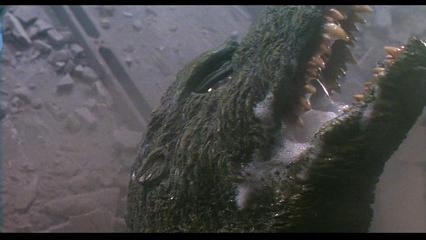

 Godzilla appears in Tokyo Bay, emerging from the water with a bellow, and begins approaching the shore. Back at the battle, Destoroyah gets back at Junior for destroying his claws by stabbing him right in the chest with the second set of jaws at the end of his tongue. After working around in there for a little bit, Destoroyah pulls his blood-soaked tongue and mandibles out of Junior, who begins foaming at the mouth and gurgling. As they watch from her news chopper, Ijuin explains to Yukari that Destoroyah is attempting to destroy Junior from the inside by injecting him with micro-oxygen and stealing his energy. While Destoroyah absorbs Junior's energy and smacks him on the sides of the neck with a couple of stumpy, crab-like claws at his front, Junior blasts him again a couple of times, creating enough force to send him crashing into this factory with a big explosion. Miki and Ozawa are ecstatic that Junior won while Junior himself, confident that his foe is defeated, turns to leave. As night begins to fall, Godzilla continues to approach Tokyo, calling for Junior, while Ijuin and Yukari circle around the spot where Destoroyah was last seen, surprised that they're unable to find his body. All that is obvious is that the place is continuing to blow up. In the next cut, it's now nighttime and Godzilla has come ashore, moving through the city as he calls for Junior. Junior, sensing his father nearby, begins calling as well. The two of them reunite at an airport, with Godzilla becoming visibly excited at having finally found his son while Junior continues calling out to him. Godzilla then begins to close the distance between himself and Junior, unaware that trouble is brewing nearby. The factory is completely destroyed in an enormous blast of energy and Destoroyah emerges in his ultimate form, fittingly surrounded by both flames and crackles of energy. Yukari and Ijuin are both astonished by the size of this new form, while their helicopter pilot decides that it's too dangerous for them to stick around and turns the helicopter around to fly off to safety. At the same time, Destoroyah, now truly the Oxygen Destroyer incarnate, takes to the air with a screech. While those at the command center watch the action, they also see that Godzilla is rapidly approaching meltdown, with his current temperature at 1140 degrees and climbing. As soon as they realize this, Ijuin contacts them and tells that they had best launch the Super-X III, saying that there's a slim chance they can reduce the damage from Godzilla's meltdown if they freeze him as soon as it happens. Another cut shows that they've decided to take Ijuin's advice and begin scrambling the Super-X III, which is quickly outfitted with enough freezer missiles and fuel for the super-cold laser cannon to do the job before it's lifted up to the runway and takes off, with the crew being told by those at the base that their prayers are with them.
Godzilla appears in Tokyo Bay, emerging from the water with a bellow, and begins approaching the shore. Back at the battle, Destoroyah gets back at Junior for destroying his claws by stabbing him right in the chest with the second set of jaws at the end of his tongue. After working around in there for a little bit, Destoroyah pulls his blood-soaked tongue and mandibles out of Junior, who begins foaming at the mouth and gurgling. As they watch from her news chopper, Ijuin explains to Yukari that Destoroyah is attempting to destroy Junior from the inside by injecting him with micro-oxygen and stealing his energy. While Destoroyah absorbs Junior's energy and smacks him on the sides of the neck with a couple of stumpy, crab-like claws at his front, Junior blasts him again a couple of times, creating enough force to send him crashing into this factory with a big explosion. Miki and Ozawa are ecstatic that Junior won while Junior himself, confident that his foe is defeated, turns to leave. As night begins to fall, Godzilla continues to approach Tokyo, calling for Junior, while Ijuin and Yukari circle around the spot where Destoroyah was last seen, surprised that they're unable to find his body. All that is obvious is that the place is continuing to blow up. In the next cut, it's now nighttime and Godzilla has come ashore, moving through the city as he calls for Junior. Junior, sensing his father nearby, begins calling as well. The two of them reunite at an airport, with Godzilla becoming visibly excited at having finally found his son while Junior continues calling out to him. Godzilla then begins to close the distance between himself and Junior, unaware that trouble is brewing nearby. The factory is completely destroyed in an enormous blast of energy and Destoroyah emerges in his ultimate form, fittingly surrounded by both flames and crackles of energy. Yukari and Ijuin are both astonished by the size of this new form, while their helicopter pilot decides that it's too dangerous for them to stick around and turns the helicopter around to fly off to safety. At the same time, Destoroyah, now truly the Oxygen Destroyer incarnate, takes to the air with a screech. While those at the command center watch the action, they also see that Godzilla is rapidly approaching meltdown, with his current temperature at 1140 degrees and climbing. As soon as they realize this, Ijuin contacts them and tells that they had best launch the Super-X III, saying that there's a slim chance they can reduce the damage from Godzilla's meltdown if they freeze him as soon as it happens. Another cut shows that they've decided to take Ijuin's advice and begin scrambling the Super-X III, which is quickly outfitted with enough freezer missiles and fuel for the super-cold laser cannon to do the job before it's lifted up to the runway and takes off, with the crew being told by those at the base that their prayers are with them.
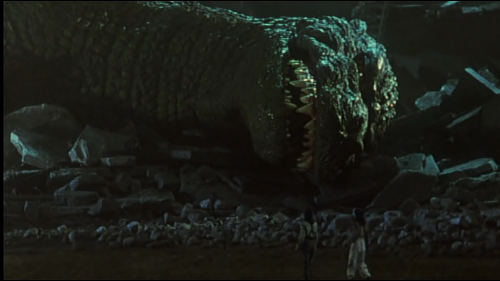


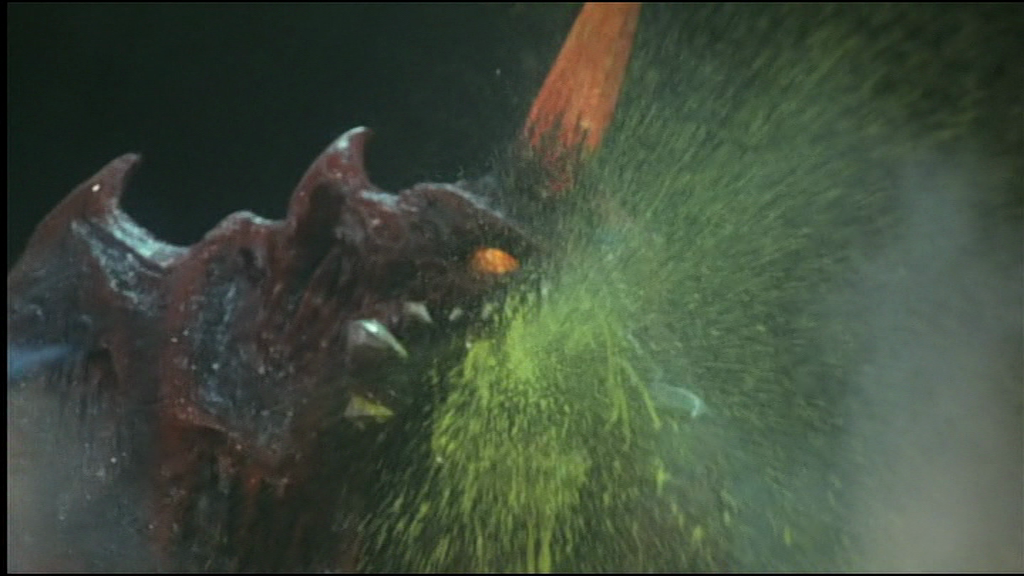

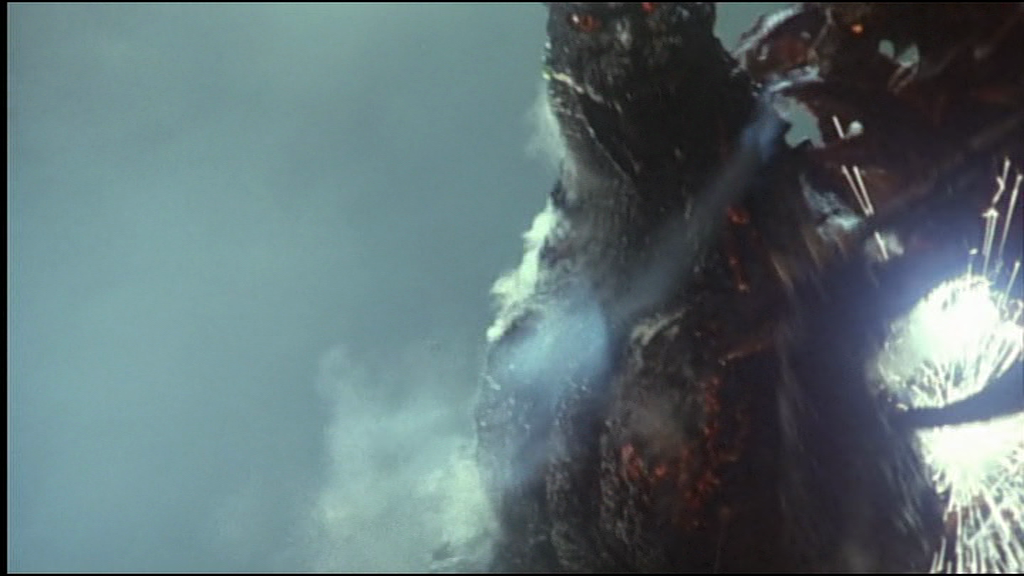
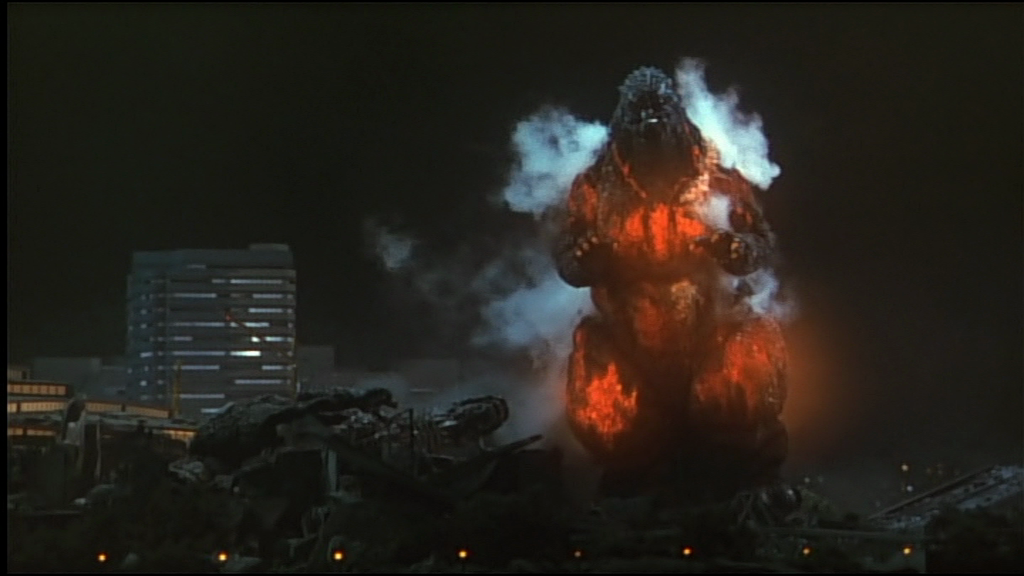

 Even though he's less than forty degrees away from death, Godzilla keeps going, wading through the water and making it back to shore, while the Super-X III approaches from the other side of the city. Despite being in a lot of pain and no doubt very weak, Godzilla marches through the airport, destroying whatever happens to be in his way, and when Destoroyah lands across from him again, he angrily begins stomping towards him, appearing smoking and steaming even more than he was before as a result of his anger. When Godzilla gets up to him, Destoroyah slices him a couple of times with his horn blade, which causes him great pain, but that doesn't stop him from blasting Destoroyah right in the chest a couple of times, creating a wound that sprays green blood. Godzilla fires again and manages to cause Destoroyah to begin vomiting blood before he goes up and slices into his torso, causing him to spray more blood. Destoroyah falls to the ground and disappears in an explosion of white steam and mist when Godzilla attempts to close in on him. While Miki and Ozawa try to make it to safety nearby, with Ozawa hurting her foot when she falls due to the rumble of a nearby explosion, Destoroyah reverts back to his juvenile forms, which explode up out of the ground and begin swarming all around Godzilla. One climbs up on the back of his neck and begins stabbing him in the head, while all the others begin swarming around his legs, with a couple attempting to get up on his tail. Despite being overwhelmed by this, Godzilla manages to grab ahold of the Destoroyah that was on his back and throws him over to the sound, causing him to disintegrate in a cloud of smoke. While Miki and Ozawa continue to try to find cover nearby, almost getting crushed when a large object falls over from the reverberations of the battle, another Destoroyah climbs up Godzilla and begins stabbing him in the back of the head again, while the others continue swarming around his legs. He attempts to fire his atomic blast but nothing except a, surprisingly, blue spark comes out of his mouth before he topples over while the one Destoroyah continues pounding him in the head. And then, the Destoroyahs all inexplicably evaporate, leaving Godzilla to get to his feet and wonder what just happened. Miki and Ozawa are finally picked up by Yukari's news chopper and flown off to safety, leaving the lifeless Junior behind. Godzilla then begins slowly approaching the spot, now glowing and smoking more than ever. Following a moment where the Super-X III, which, for some reason that we're never told, takes off again from the ground, and Lt. Kuroki tells them to stand by to freeze Godzilla when his temperature reaches 1200, they pass over Godzilla as he walks up to his son, with Godzilla roaring at them for a moment before going back to the task at hand. With his temperature now at 1172, he walks up to his son, who is actually just barely alive, and bends down towards him, attempting to breathe life into him by passing some radiation through his body. Junior does react to this but, sadly, he's too far gone for it to be of any use and he closes his eyes. Realizing that his son is dead, Godzilla stands back up and his grief exacerbates his condition, causing a surge of energy within him that forces him to expel a blast from his mouth.
Even though he's less than forty degrees away from death, Godzilla keeps going, wading through the water and making it back to shore, while the Super-X III approaches from the other side of the city. Despite being in a lot of pain and no doubt very weak, Godzilla marches through the airport, destroying whatever happens to be in his way, and when Destoroyah lands across from him again, he angrily begins stomping towards him, appearing smoking and steaming even more than he was before as a result of his anger. When Godzilla gets up to him, Destoroyah slices him a couple of times with his horn blade, which causes him great pain, but that doesn't stop him from blasting Destoroyah right in the chest a couple of times, creating a wound that sprays green blood. Godzilla fires again and manages to cause Destoroyah to begin vomiting blood before he goes up and slices into his torso, causing him to spray more blood. Destoroyah falls to the ground and disappears in an explosion of white steam and mist when Godzilla attempts to close in on him. While Miki and Ozawa try to make it to safety nearby, with Ozawa hurting her foot when she falls due to the rumble of a nearby explosion, Destoroyah reverts back to his juvenile forms, which explode up out of the ground and begin swarming all around Godzilla. One climbs up on the back of his neck and begins stabbing him in the head, while all the others begin swarming around his legs, with a couple attempting to get up on his tail. Despite being overwhelmed by this, Godzilla manages to grab ahold of the Destoroyah that was on his back and throws him over to the sound, causing him to disintegrate in a cloud of smoke. While Miki and Ozawa continue to try to find cover nearby, almost getting crushed when a large object falls over from the reverberations of the battle, another Destoroyah climbs up Godzilla and begins stabbing him in the back of the head again, while the others continue swarming around his legs. He attempts to fire his atomic blast but nothing except a, surprisingly, blue spark comes out of his mouth before he topples over while the one Destoroyah continues pounding him in the head. And then, the Destoroyahs all inexplicably evaporate, leaving Godzilla to get to his feet and wonder what just happened. Miki and Ozawa are finally picked up by Yukari's news chopper and flown off to safety, leaving the lifeless Junior behind. Godzilla then begins slowly approaching the spot, now glowing and smoking more than ever. Following a moment where the Super-X III, which, for some reason that we're never told, takes off again from the ground, and Lt. Kuroki tells them to stand by to freeze Godzilla when his temperature reaches 1200, they pass over Godzilla as he walks up to his son, with Godzilla roaring at them for a moment before going back to the task at hand. With his temperature now at 1172, he walks up to his son, who is actually just barely alive, and bends down towards him, attempting to breathe life into him by passing some radiation through his body. Junior does react to this but, sadly, he's too far gone for it to be of any use and he closes his eyes. Realizing that his son is dead, Godzilla stands back up and his grief exacerbates his condition, causing a surge of energy within him that forces him to expel a blast from his mouth.
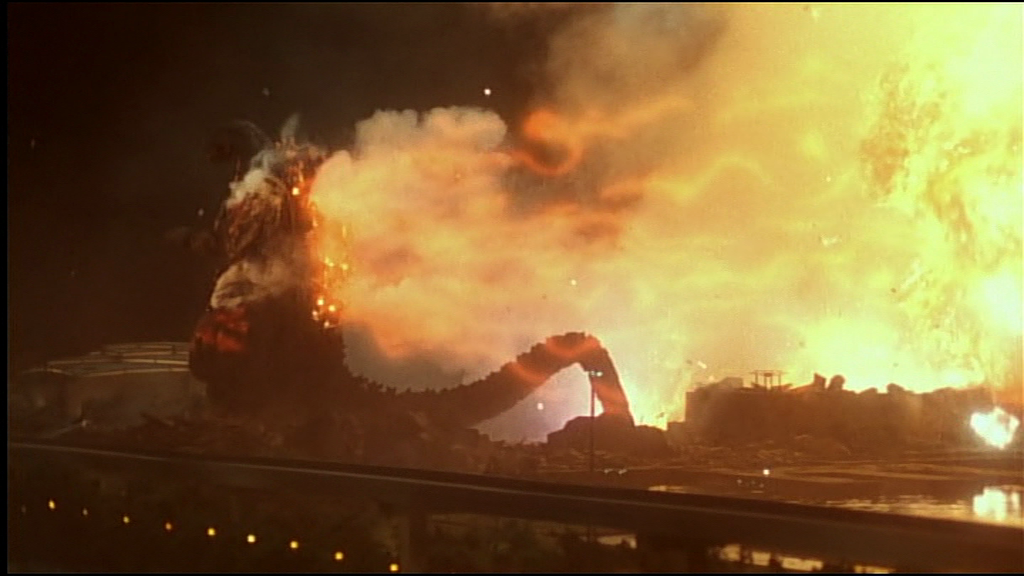
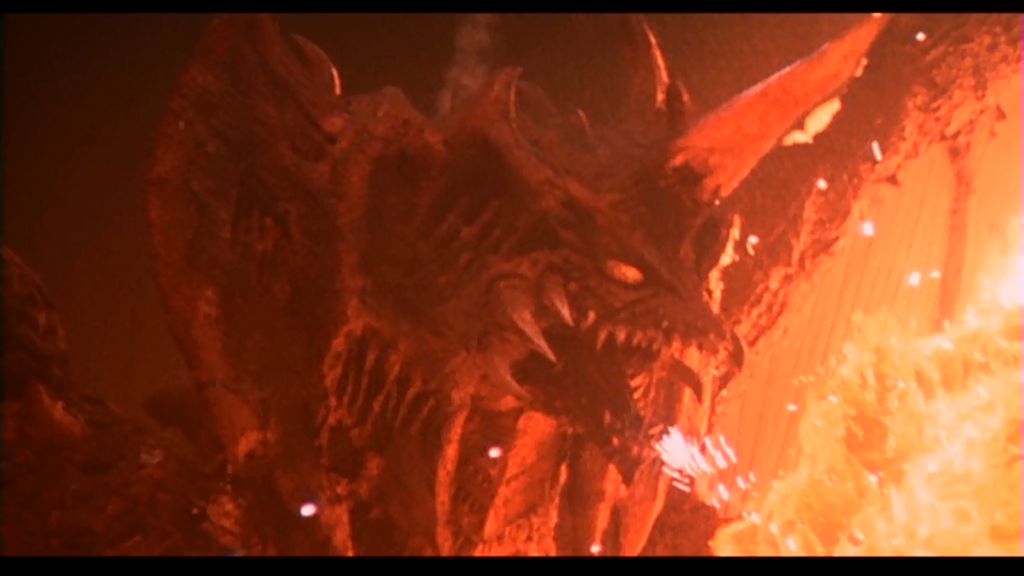 As he's grieving, Godzilla gets blasted from behind and turns around to see Destoroyah, now having returned to his ultimate form, heading right for him. Destoroyah blasts him again as he comes around to his front, flying at Godzilla and grabbing him by the neck with his tail again, forcing him to the ground. Destoroyah then attempts to suck energy from Godzilla but the Big G apparently proves to be literally too hot to handle and Destoroyah flings him around the site before ultimately throwing him into another part of the seaside development complex. Godzilla gets to his feet and begins exhibiting a green glow, a sign that he's becoming more and more unstable. His internal temperature begins approaching critical, reaching the low 1180's, and his spines begin to melt from the extreme heat. The melting is accompanied by a blinding flash of energy and is followed by massive amounts of nuclear energy draining off his back, destroying everything directly behind him, while Destoroyah watches. Lt. Kuroki orders all of the maser-freezer units to get into position, knowing that there's not much time left. As they do so, Godzilla's out of control power begins blowing up everything around him, while his atomic blast, which he fires at Destoroyah, is now strong enough to create a massive line of explosions towards its target. Destoroyah begins reeling from the direct hits of this powerful ray, with the right side of his head being badly scarred by a direct hit. As the Super-X III and the maser freezer units continue to wait for him to hit 1200 degrees, Godzilla blasts Destoroyah a couple of more times, really hurting the monster and causing even more destruction to the surrounding area. Destoroyah, realizing that he's not going to be able to win now, takes to the sky and attempts to escape. But, before he can get away, the freezer masers and the Super-X III open fire on him, blasting until he loses his ability and drops back down to the ground, landing in front of Godzilla and instantly disintegrating in a cloud of smoke. Like I said earlier, it was a huge mistake to not let Godzilla deliver the killing blow to Destoroyah, given that he's about to die and that this is the monster that killed Junior. In fact, the film's original ending had Destoroyah survive his fall and he and Godzilla resume their battle as the meltdown happens and they die together. However, the filmmakers realized that it didn't have the necessary pathos, which it didn't, and re-filmed it to this ending so Godzilla's death could be the centerpiece of the film's ending. What I don't get is why they didn't just allow Destoroyah to survive the fall to the ground, have Godzilla tear him apart and blow him to pieces, and then have him meltdown. That would have been a far more satisfying conclusion to their fight and you would have still had the pathos and sympathy of watching Godzilla die. I just don't know why they didn't think to do that.
As he's grieving, Godzilla gets blasted from behind and turns around to see Destoroyah, now having returned to his ultimate form, heading right for him. Destoroyah blasts him again as he comes around to his front, flying at Godzilla and grabbing him by the neck with his tail again, forcing him to the ground. Destoroyah then attempts to suck energy from Godzilla but the Big G apparently proves to be literally too hot to handle and Destoroyah flings him around the site before ultimately throwing him into another part of the seaside development complex. Godzilla gets to his feet and begins exhibiting a green glow, a sign that he's becoming more and more unstable. His internal temperature begins approaching critical, reaching the low 1180's, and his spines begin to melt from the extreme heat. The melting is accompanied by a blinding flash of energy and is followed by massive amounts of nuclear energy draining off his back, destroying everything directly behind him, while Destoroyah watches. Lt. Kuroki orders all of the maser-freezer units to get into position, knowing that there's not much time left. As they do so, Godzilla's out of control power begins blowing up everything around him, while his atomic blast, which he fires at Destoroyah, is now strong enough to create a massive line of explosions towards its target. Destoroyah begins reeling from the direct hits of this powerful ray, with the right side of his head being badly scarred by a direct hit. As the Super-X III and the maser freezer units continue to wait for him to hit 1200 degrees, Godzilla blasts Destoroyah a couple of more times, really hurting the monster and causing even more destruction to the surrounding area. Destoroyah, realizing that he's not going to be able to win now, takes to the sky and attempts to escape. But, before he can get away, the freezer masers and the Super-X III open fire on him, blasting until he loses his ability and drops back down to the ground, landing in front of Godzilla and instantly disintegrating in a cloud of smoke. Like I said earlier, it was a huge mistake to not let Godzilla deliver the killing blow to Destoroyah, given that he's about to die and that this is the monster that killed Junior. In fact, the film's original ending had Destoroyah survive his fall and he and Godzilla resume their battle as the meltdown happens and they die together. However, the filmmakers realized that it didn't have the necessary pathos, which it didn't, and re-filmed it to this ending so Godzilla's death could be the centerpiece of the film's ending. What I don't get is why they didn't just allow Destoroyah to survive the fall to the ground, have Godzilla tear him apart and blow him to pieces, and then have him meltdown. That would have been a far more satisfying conclusion to their fight and you would have still had the pathos and sympathy of watching Godzilla die. I just don't know why they didn't think to do that.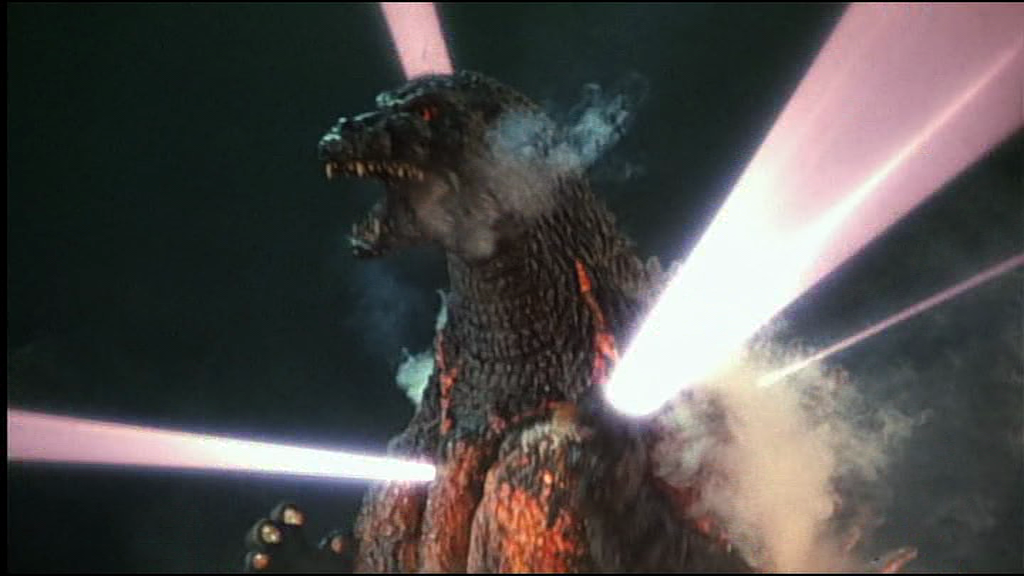
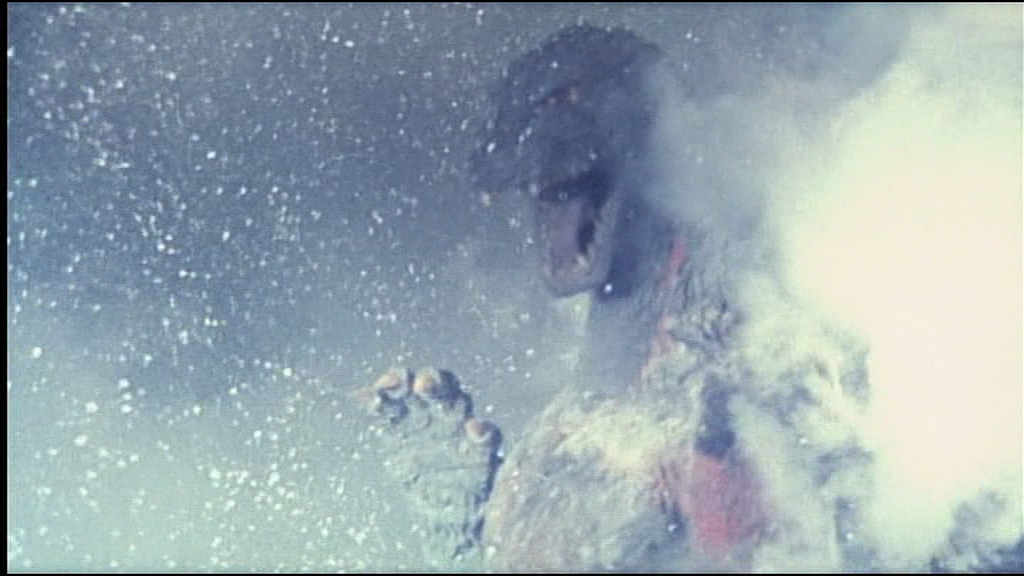
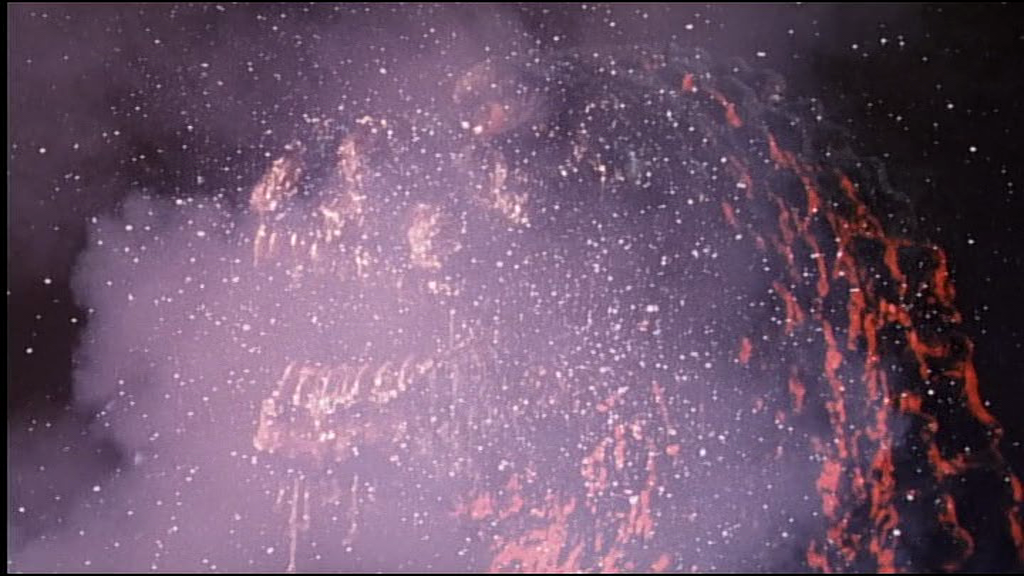
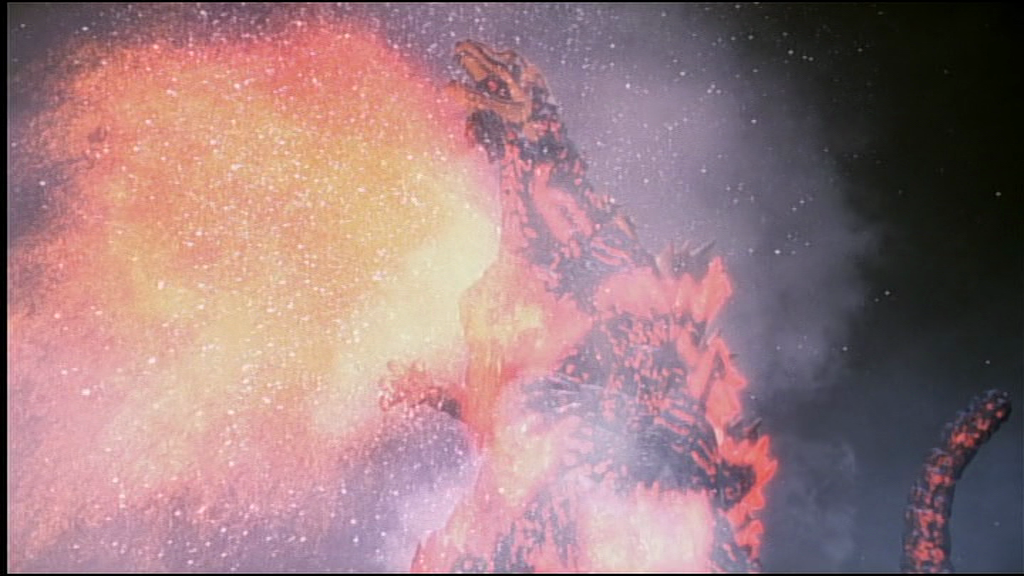

 With Destoroyah now dead, and with his power continuing to rage within him, Godzilla meanders around and waits to die. His temperature hits 1192 and he roars in pain as a burst of energy courses through his spines, forcing to him to shoot off his atomic blast into the air. The green glow emanating from him becomes more prominent and his spines continuing to flash as Godzilla quietly growls. With that, he finally hits 1200 and a bright, white light pours of him, accompanied by a shower of radioactive particles that discharge straight up, while his spines continue sparking. As he continues writhing and growling, Lt. Kuroki orders all of the units, including the Super-X III, to begin firing. The aircraft hits him at full power and with their energy at their limit, while maser units come in from the side and begin doing the same. Godzilla turns around and roars at the Super-X III but doesn't fight back at all, as the radiation levels go through the roof. All of the units continue firing, creating so much ice mist that Godzilla becomes hard to see, and the glow emanating from him becomes bright enough to fill both the command center as they watch on their video screen and the cockpit of the Super-X III. As it all clears, we see Godzilla's face begin falling apart and disintegrating and in a shot of his entire body, we see an explosion erupt out of his chest as his heart finally gives out and the flesh melts off his head, revealing his skull. He gives out one last pained roar before he literally falls apart and vanishes into nothingness, leaving behind a glowing white cloud of radioactivity and particles that continue to head up into the sky. While Miki and Ozawa watch with tears in their eyes, Ijuin comments that while the Earth has been saved, Tokyo is now a dead city. Yukari laments that this might be their final punishment for, "Playing with nuclear power for mankind's sake." As everyone in the command center watches the video screen, Miki sadly says that her mission has finally ended, while the radioactive glow slowly dissipates. That's when they notice that the radiation levels are dropping dramatically and, as the smoke and mist clear, a familiar silhouette appears. Godzilla Junior has absorbed his father's radiation and has now been revived as a full fledged adult. The camera pushes in on the new King of the Monsters as his roar echoes loudly, which, combined with how he's backlit with shafts of light projecting from behind him, makes for an unforgettable and haunting image, and with that, the credits roll over footage from the original Godzilla and all of the entries in the Heisei series, from The Return of Godzilla to here.
With Destoroyah now dead, and with his power continuing to rage within him, Godzilla meanders around and waits to die. His temperature hits 1192 and he roars in pain as a burst of energy courses through his spines, forcing to him to shoot off his atomic blast into the air. The green glow emanating from him becomes more prominent and his spines continuing to flash as Godzilla quietly growls. With that, he finally hits 1200 and a bright, white light pours of him, accompanied by a shower of radioactive particles that discharge straight up, while his spines continue sparking. As he continues writhing and growling, Lt. Kuroki orders all of the units, including the Super-X III, to begin firing. The aircraft hits him at full power and with their energy at their limit, while maser units come in from the side and begin doing the same. Godzilla turns around and roars at the Super-X III but doesn't fight back at all, as the radiation levels go through the roof. All of the units continue firing, creating so much ice mist that Godzilla becomes hard to see, and the glow emanating from him becomes bright enough to fill both the command center as they watch on their video screen and the cockpit of the Super-X III. As it all clears, we see Godzilla's face begin falling apart and disintegrating and in a shot of his entire body, we see an explosion erupt out of his chest as his heart finally gives out and the flesh melts off his head, revealing his skull. He gives out one last pained roar before he literally falls apart and vanishes into nothingness, leaving behind a glowing white cloud of radioactivity and particles that continue to head up into the sky. While Miki and Ozawa watch with tears in their eyes, Ijuin comments that while the Earth has been saved, Tokyo is now a dead city. Yukari laments that this might be their final punishment for, "Playing with nuclear power for mankind's sake." As everyone in the command center watches the video screen, Miki sadly says that her mission has finally ended, while the radioactive glow slowly dissipates. That's when they notice that the radiation levels are dropping dramatically and, as the smoke and mist clear, a familiar silhouette appears. Godzilla Junior has absorbed his father's radiation and has now been revived as a full fledged adult. The camera pushes in on the new King of the Monsters as his roar echoes loudly, which, combined with how he's backlit with shafts of light projecting from behind him, makes for an unforgettable and haunting image, and with that, the credits roll over footage from the original Godzilla and all of the entries in the Heisei series, from The Return of Godzilla to here. As you probably guessed, the other member of the original Godzilla team whose last involvement with the character consisted of this film was composer Akira Ifukube. After this film, Ifukube once again retired from film-scoring, this time for good, and eventually died in 2006 at the age of 91. He supposedly felt that this score was the best work he ever did and while it would definitely be hard to choose one score out of the over 270 he composed in his nearly 50-year career as his best, this one is definitely a keeper. It's a score that hits precisely all the right notes, from big and majestic to horrifying and bombastic, and most effectively of all, to downright touching and tear-jerking. The theme that opens the film, which is the loud, powerful music that plays when Godzilla first appears and attacks Hong Kong is a nice reworking of his familiar theme for the monster, emphasizing the out of control power currently raging within him. This theme is hinted at a couple of times throughout the film but is not heard at its full strength again until near the end when Godzilla is quickly approaching his meltdown and is causing massive destruction as he continues to battle Destoroyah. Speaking of which, Destoroyah's is the bombastic, horrific theme that I mentioned, fitting well with his violent, merciless nature and how he's actually a creation of man gone awry in the worst way imaginable. This theme is actually first heard during the latter part of Godzilla's Hong Kong rampage after the title and makes for an interesting connection between the two monsters. The theme is played in many different ways, from soft and ominous, as in the scene in the aquarium, to slower and more horrific in tone, such as when the special forces soldiers battle the juvenile Destoroyahs, and much faster-paced and more frantic like during the scene where Godzilla battles the juveniles as well as when Destoroyah appears again and attacks him from behind afterward. Also, when Destoroyah's ultimate form is revealed for the first time, the music into a very loud and powerful "dun-dun" that really suits the tone of the moment. Ifukube once again proves that he's great at writing military marches with the very stirring theme for the Super-X III and when the military moves in to combat the juvenile Destoroyahs at the construction site, I'm pretty sure that the music there is a recreation of a theme he did in the original Japanese version of War of the Gargantuas. Speaking of recreating old themes, Ifukube also makes a nice one for the flashbacks to the original Godzilla, perfectly recapturing the spirit and tone of that movie. The theme he created for Baby Godzilla back in Godzilla vs. Mechagodzilla II makes a return here for Godzilla Junior and like before, it's a rather sad-sounding and touching theme that gets across how he's an innocent creature who's once again being used for man's purposes and is especially heartbreaking to hear when he's mortally wounded by Destoroyah and when Godzilla fails to breathe life back into him. However, that's nothing compared to the extremely sad requiem piece Ifukube composes for Godzilla when he melts down. Needless to say, it perfectly captures the sadness and the tragedy of the Big G as he succumbs to the effects of his own power, particularly during the latter part of it when you have a woman vocalizing and some really sad music to go along with it. It gets across that he's truly gone and that he's left nothing but white, radioactive mist and a dead city in his wake. If you're a Godzilla fan, it's virtually impossible to watch that scene and hear that music without getting a lump in your throat. But, once that's all said and done, when the film ends after the reveal that he's reborn in Junior, it does so on a more triumphant and celebratory note, with a sweeping symphony of the Godzilla March that caps off with a bit of an instrumental recap of the tribal song from King Kong vs. Godzilla before climaxing with one last section from the march and a brief but stirring finale. Combined with the footage from past films playing under the credits, it's nothing less than a great nostalgia trip and a perfect note for both the series and Ifukube to end on.
 Out of all of the English versions of the Heisei entries, Godzilla vs. Destoroyah has to be the one that's the most different from the Japanese version. Now, save for the opening credits and the shortening of the ending ones (a colossal mistake, I might add), not a frame of the actual film was touched but the dialogue was changed so significantly that it almost alters the story and some of the characters. When I finally saw the Japanese version, I was really surprised at how different the two versions were from each other. For instance, the explanation for Godzilla's condition is completely different. In the Japanese version, it's a condition that's been building within him for a month before the film's story begins and it was his power that destroyed Birth Island; in the English dub, it's said that Birth Island was destroyed by a discharge of pure uranium and that explosion of incredible radioactivity is did this to Godzilla. What's more, when it becomes apparent that he will meltdown rather than explode in the Japanese version, Kenichi says that the nuclear fission within him is taking hold, while in the English version, he says, "We managed to control the fission, but his reactor {his heart} must be breaking up." Speaking of Kenichi, he's much less pompous and obnoxious in the dub. In this version, the reason Prof. Fukazawa visits him is to actually ask him to come work at the UNGCC and Kenichi initially refuses, saying that studying Godzilla is nothing more than a hobby to him. Like in the Japanese version, learning that Miki Saegusa is working at the center is what motivates him to go but the circumstances are completely different. In this version, Kenichi even says that he initially sent his theory on Godzilla to the Japanese G-Center but they ignored it, which forced him to send it to America. Also, in the dub, Dr. Ijuin says that he actually made reference to Dr. Serizawa's research, even though, as Emiko reminds us (in both versions, I think), Serizawa destroyed all of his notes before allowing the Oxygen Destroyer to be used. Another change that made things make less sense is when Kenichi suggests allowing Godzilla and Destoroyah to fight each other. In the Japanese version, Commander Aso shoots down his idea and Fukazawa tells him that he'd better be sure of his plan before he feels comfortable to risk people's lives in doing so, which prompts Kenichi to berate both of them. In the English dub, Aso calls his plan preposterous but Fukazawa says, "Maybe it's not so preposterous. Maybe he's got something there." And yet, despite that, Kenichi still impertinently tells them that they must put this plan into motion, with Fukazawa now suddenly having a change of emotion when he asks, "Yes, but how are we going to get them to fight each other?" I could go on but I think you get the picture. I don't think any other Godzilla movie was changed so much simply via the rewriting of dialogue. To be honest, though, I like some of the lines in the dub better than the ones in the Japanese version, like Miki's last line of, "My job is done now, Godzilla." I'm kind of on the fence when it comes to the two different explanations for Godzilla's condition, though, because I think it being a side-effect of his growing power is more impactful than the result of an accident. I remember the voices for this dub being pretty fair, although there are, again, too few of them and it can be confusing to hear two or more people with the same voice. Besides the actual spelling, they do call the antagonistic monster "Destroyer" in the dub, which was the English title that Toho wanted to go with (the Godzilla Compendium lists Godzilla vs. Destroyer as an alternate title) but they couldn't copyright a word as common as that so they had to rework the spelling, leading to the awkwardly-spelled name we have hear. And finally, this is definitely an instance where I think they made a mistake in cutting short the ending credits because it deprives you of the awesome montage and symphony of the Godzilla March that ends the film on a perfect note.
Out of all of the English versions of the Heisei entries, Godzilla vs. Destoroyah has to be the one that's the most different from the Japanese version. Now, save for the opening credits and the shortening of the ending ones (a colossal mistake, I might add), not a frame of the actual film was touched but the dialogue was changed so significantly that it almost alters the story and some of the characters. When I finally saw the Japanese version, I was really surprised at how different the two versions were from each other. For instance, the explanation for Godzilla's condition is completely different. In the Japanese version, it's a condition that's been building within him for a month before the film's story begins and it was his power that destroyed Birth Island; in the English dub, it's said that Birth Island was destroyed by a discharge of pure uranium and that explosion of incredible radioactivity is did this to Godzilla. What's more, when it becomes apparent that he will meltdown rather than explode in the Japanese version, Kenichi says that the nuclear fission within him is taking hold, while in the English version, he says, "We managed to control the fission, but his reactor {his heart} must be breaking up." Speaking of Kenichi, he's much less pompous and obnoxious in the dub. In this version, the reason Prof. Fukazawa visits him is to actually ask him to come work at the UNGCC and Kenichi initially refuses, saying that studying Godzilla is nothing more than a hobby to him. Like in the Japanese version, learning that Miki Saegusa is working at the center is what motivates him to go but the circumstances are completely different. In this version, Kenichi even says that he initially sent his theory on Godzilla to the Japanese G-Center but they ignored it, which forced him to send it to America. Also, in the dub, Dr. Ijuin says that he actually made reference to Dr. Serizawa's research, even though, as Emiko reminds us (in both versions, I think), Serizawa destroyed all of his notes before allowing the Oxygen Destroyer to be used. Another change that made things make less sense is when Kenichi suggests allowing Godzilla and Destoroyah to fight each other. In the Japanese version, Commander Aso shoots down his idea and Fukazawa tells him that he'd better be sure of his plan before he feels comfortable to risk people's lives in doing so, which prompts Kenichi to berate both of them. In the English dub, Aso calls his plan preposterous but Fukazawa says, "Maybe it's not so preposterous. Maybe he's got something there." And yet, despite that, Kenichi still impertinently tells them that they must put this plan into motion, with Fukazawa now suddenly having a change of emotion when he asks, "Yes, but how are we going to get them to fight each other?" I could go on but I think you get the picture. I don't think any other Godzilla movie was changed so much simply via the rewriting of dialogue. To be honest, though, I like some of the lines in the dub better than the ones in the Japanese version, like Miki's last line of, "My job is done now, Godzilla." I'm kind of on the fence when it comes to the two different explanations for Godzilla's condition, though, because I think it being a side-effect of his growing power is more impactful than the result of an accident. I remember the voices for this dub being pretty fair, although there are, again, too few of them and it can be confusing to hear two or more people with the same voice. Besides the actual spelling, they do call the antagonistic monster "Destroyer" in the dub, which was the English title that Toho wanted to go with (the Godzilla Compendium lists Godzilla vs. Destroyer as an alternate title) but they couldn't copyright a word as common as that so they had to rework the spelling, leading to the awkwardly-spelled name we have hear. And finally, this is definitely an instance where I think they made a mistake in cutting short the ending credits because it deprives you of the awesome montage and symphony of the Godzilla March that ends the film on a perfect note. Godzilla vs. Destoroyah is most certainly one of the best Heisei entries, as well as one of the best Godzilla movies overall. It's one of those films where nearly everything works, from the tone and emotion to the pacing, the special effects, the action scenes, and the score. The raised stakes make the film much more impactful than some of the previous ones, the story is well-told and has a great connection to the original movie in the form of the antagonistic monster, the special effects are awesome to say the least, the monster battles have quite a bit of tension to them since a lot is on the line, the emotion that the film is going for is genuine and just gut-wrenching at times, especially the ending and Godzilla's meltdown, the music is just wonderful and fits the film like a glove, and the whole thing ultimately leaves you on a nostalgic and triumphant note with the nice montage that plays behind the ending credits. There are flaws, like the characters mostly being nothing more than archetypes rather than 3-dimensional people, some occasional dodgy special effects, and Godzilla not being able to actually kill Destoroyah before he melts down but, those issues aside, this is both a great Godzilla movie and an overall great film as well and would have made for a nice and fitting cap on the series. I definitely recommend it, although I caution you if you're a very emotional person as well as a Godzilla fan because, as I've described, the movie packs quite a punch in that respect.
Godzilla vs. Destoroyah is most certainly one of the best Heisei entries, as well as one of the best Godzilla movies overall. It's one of those films where nearly everything works, from the tone and emotion to the pacing, the special effects, the action scenes, and the score. The raised stakes make the film much more impactful than some of the previous ones, the story is well-told and has a great connection to the original movie in the form of the antagonistic monster, the special effects are awesome to say the least, the monster battles have quite a bit of tension to them since a lot is on the line, the emotion that the film is going for is genuine and just gut-wrenching at times, especially the ending and Godzilla's meltdown, the music is just wonderful and fits the film like a glove, and the whole thing ultimately leaves you on a nostalgic and triumphant note with the nice montage that plays behind the ending credits. There are flaws, like the characters mostly being nothing more than archetypes rather than 3-dimensional people, some occasional dodgy special effects, and Godzilla not being able to actually kill Destoroyah before he melts down but, those issues aside, this is both a great Godzilla movie and an overall great film as well and would have made for a nice and fitting cap on the series. I definitely recommend it, although I caution you if you're a very emotional person as well as a Godzilla fan because, as I've described, the movie packs quite a punch in that respect.